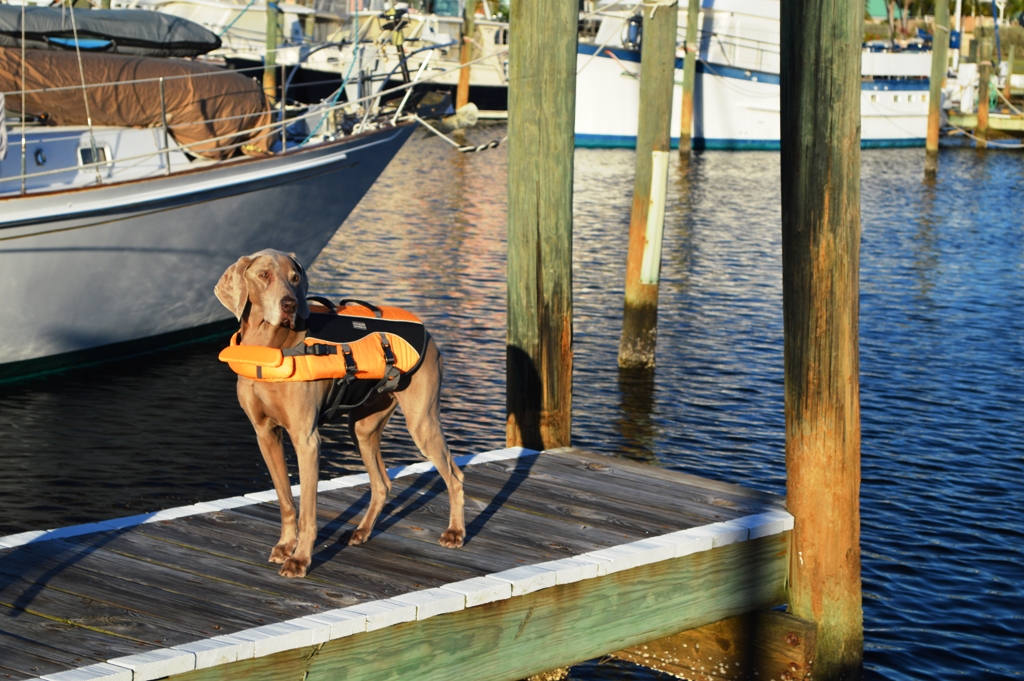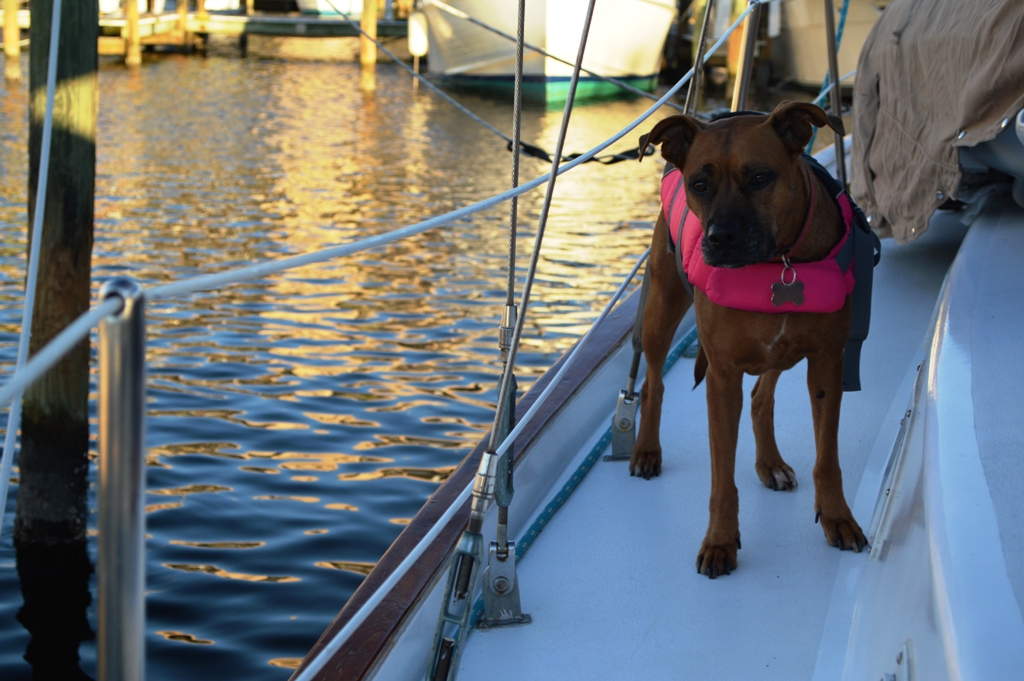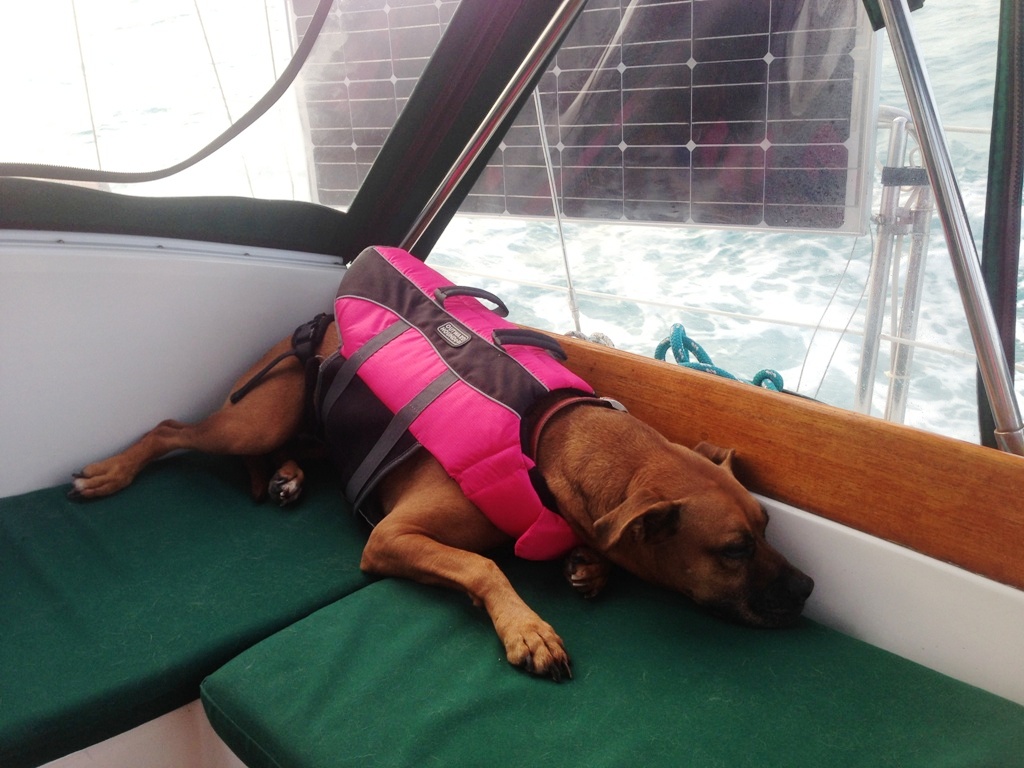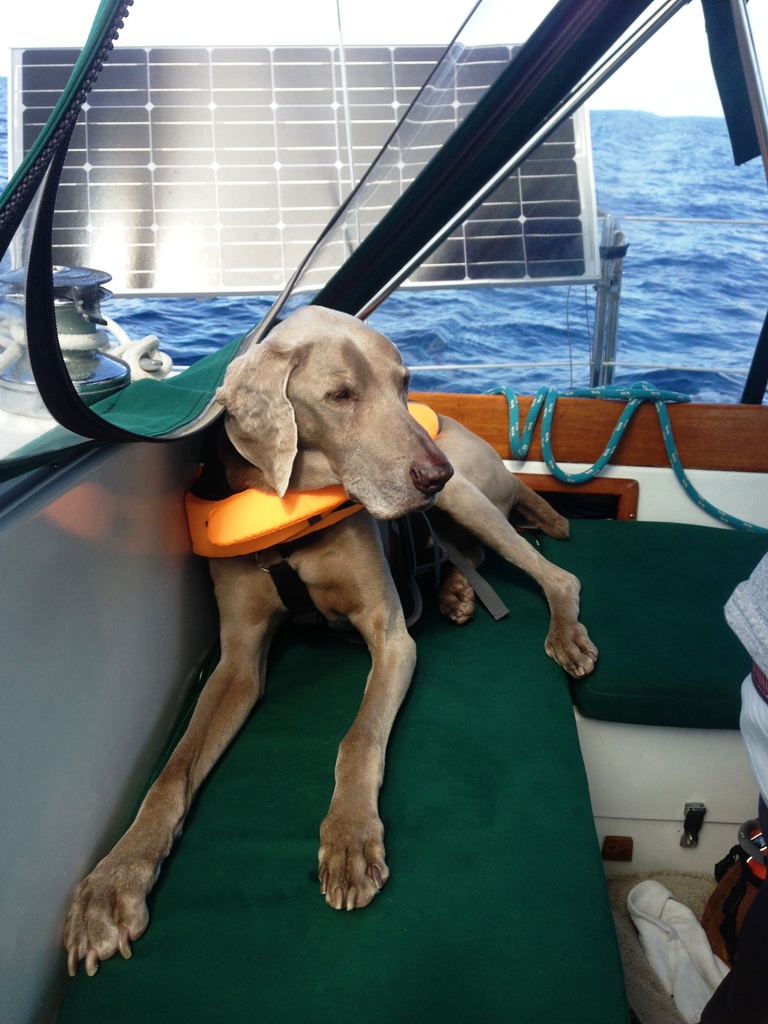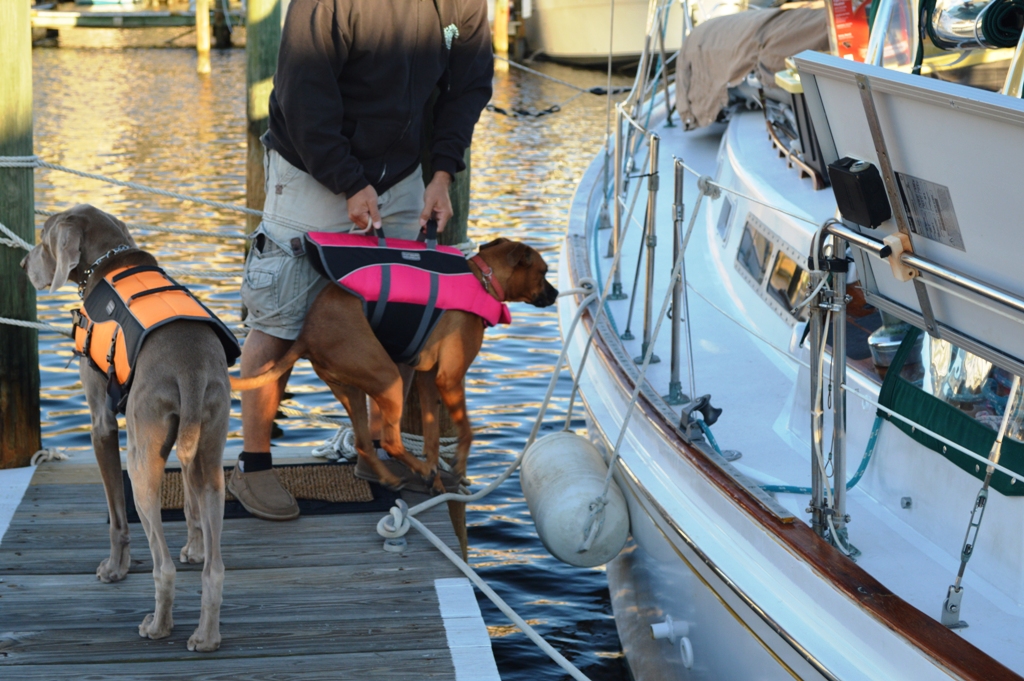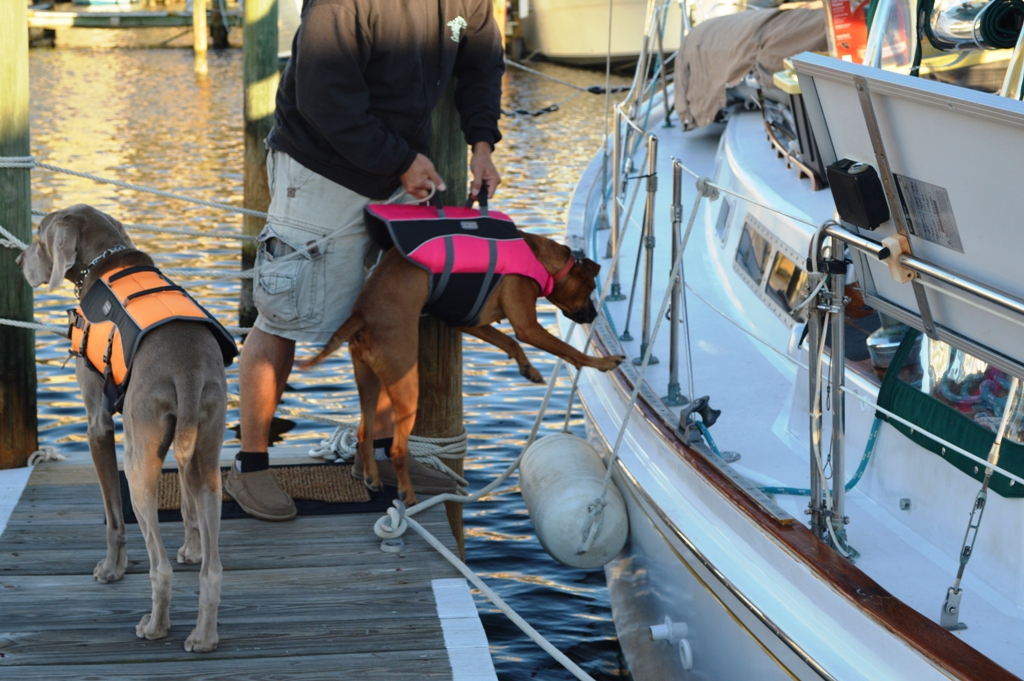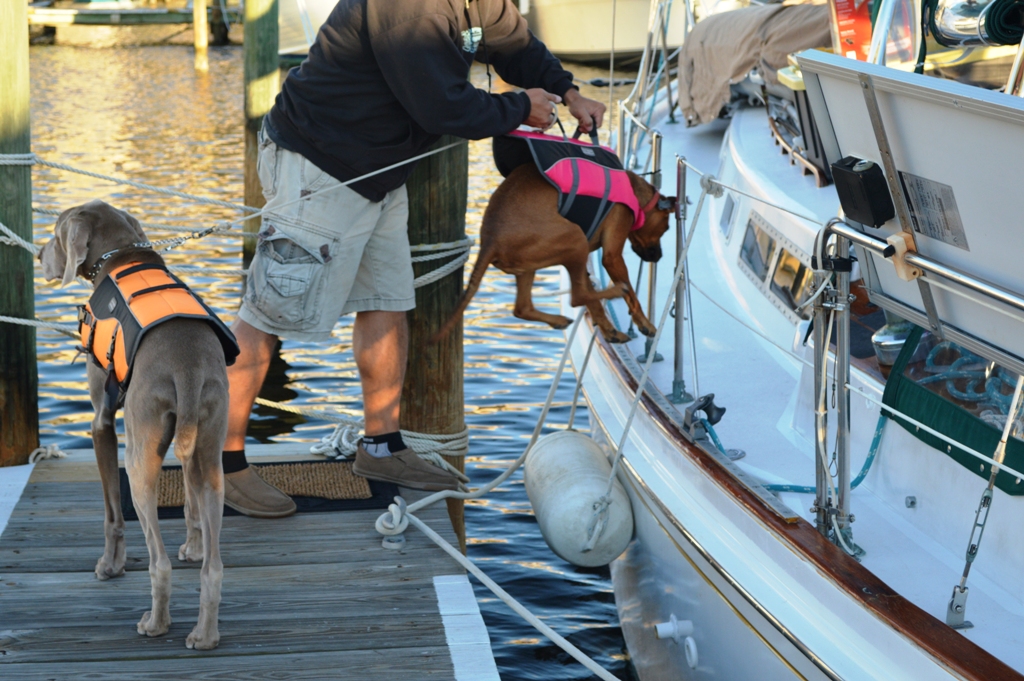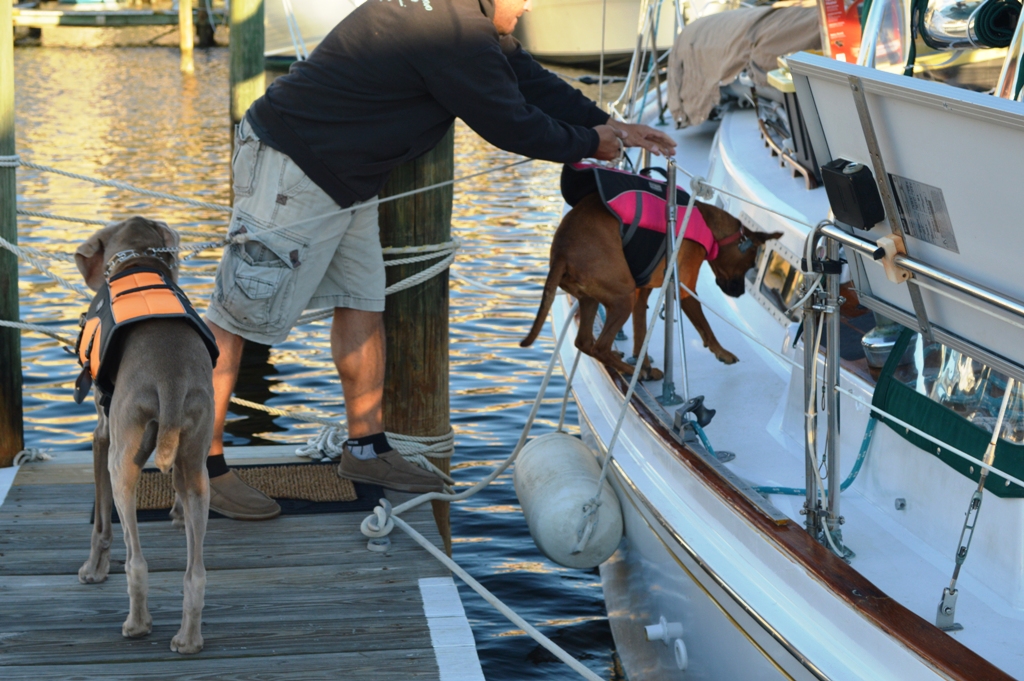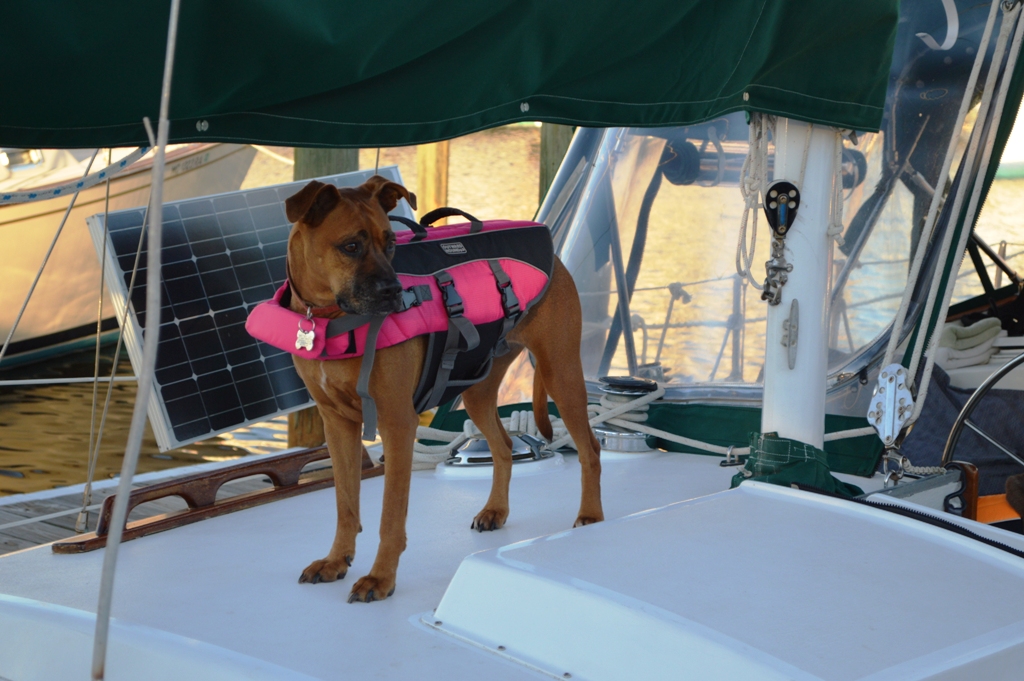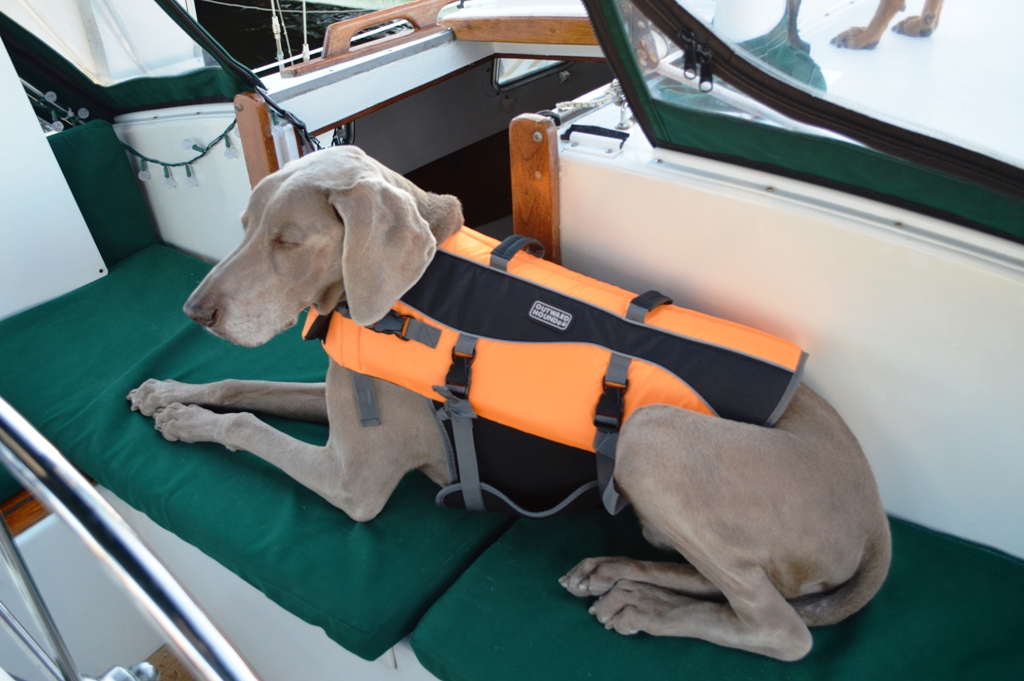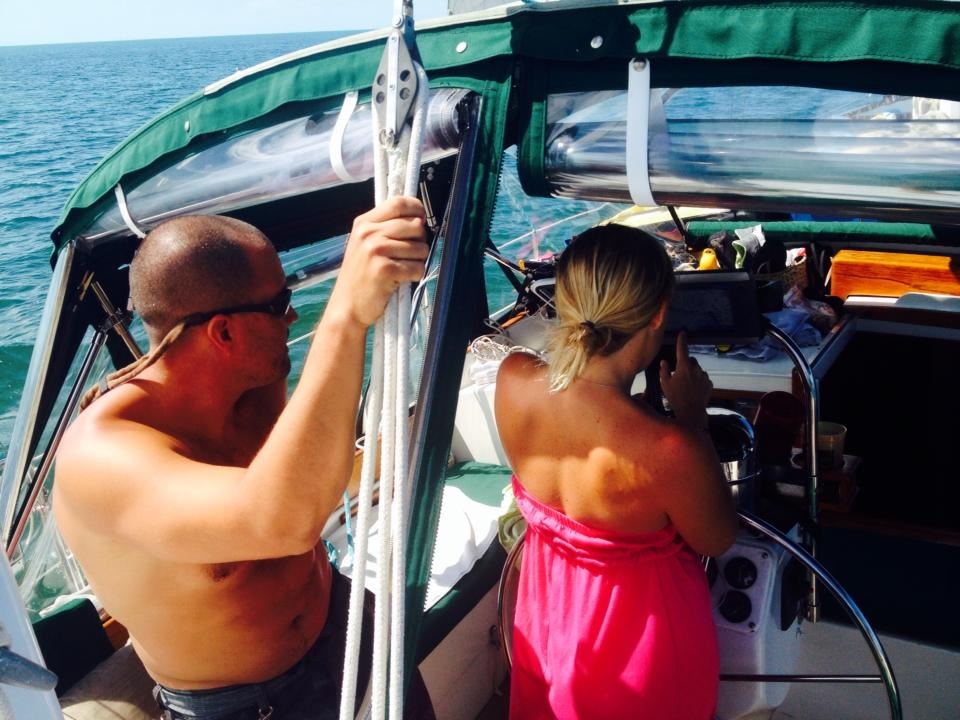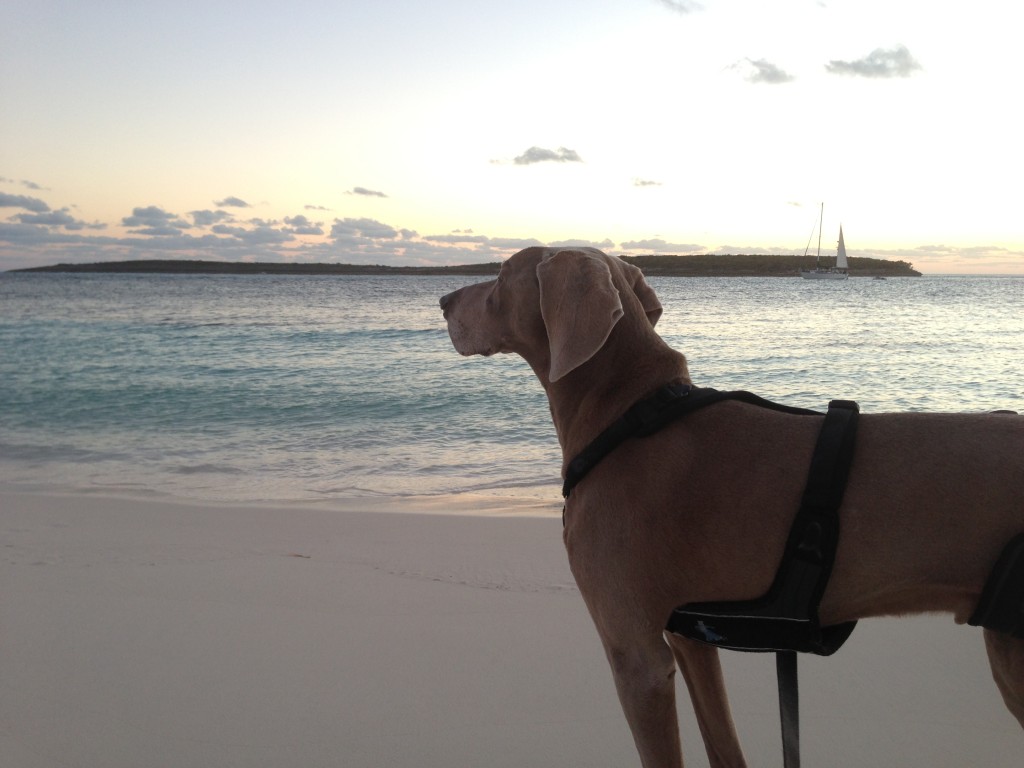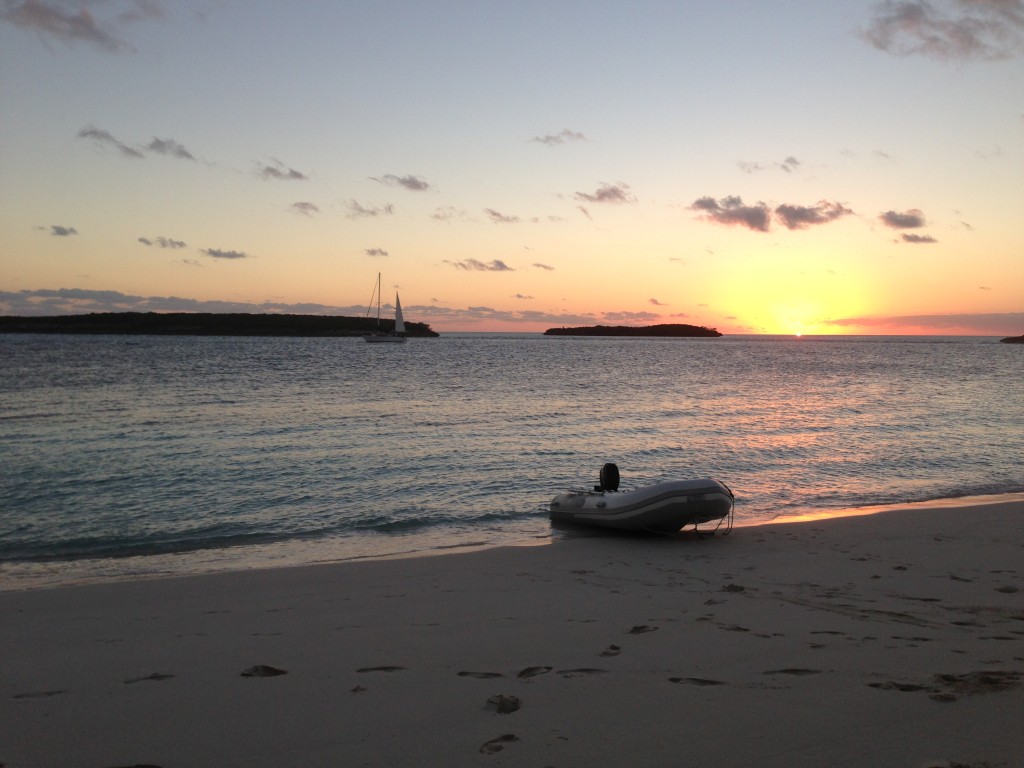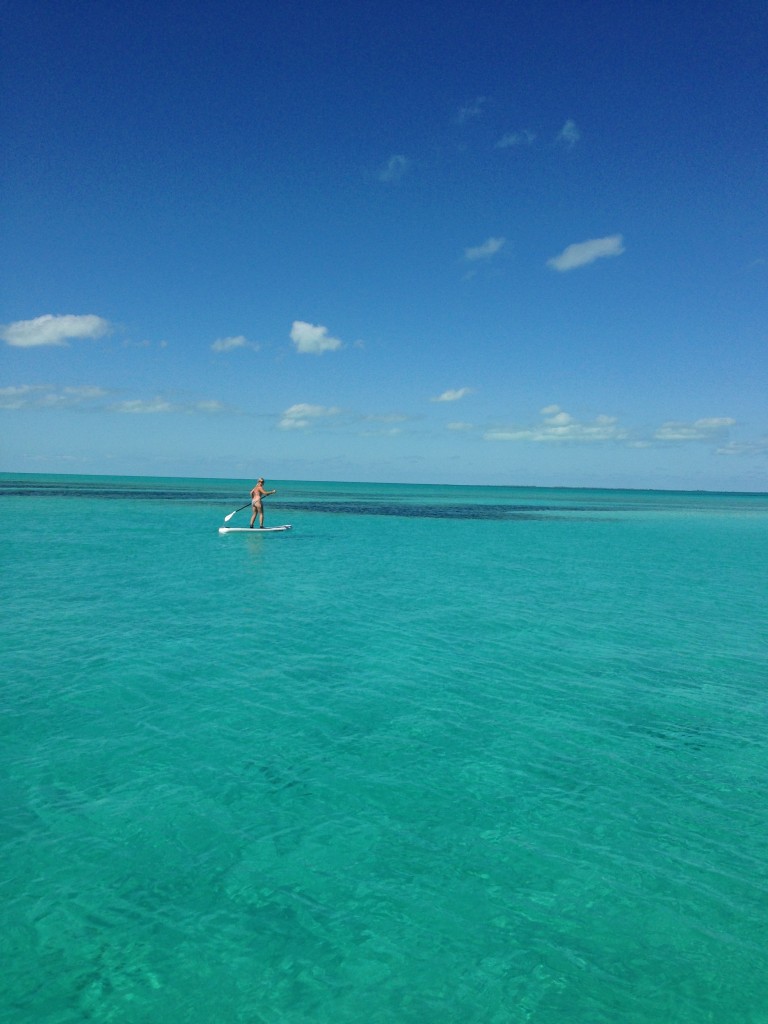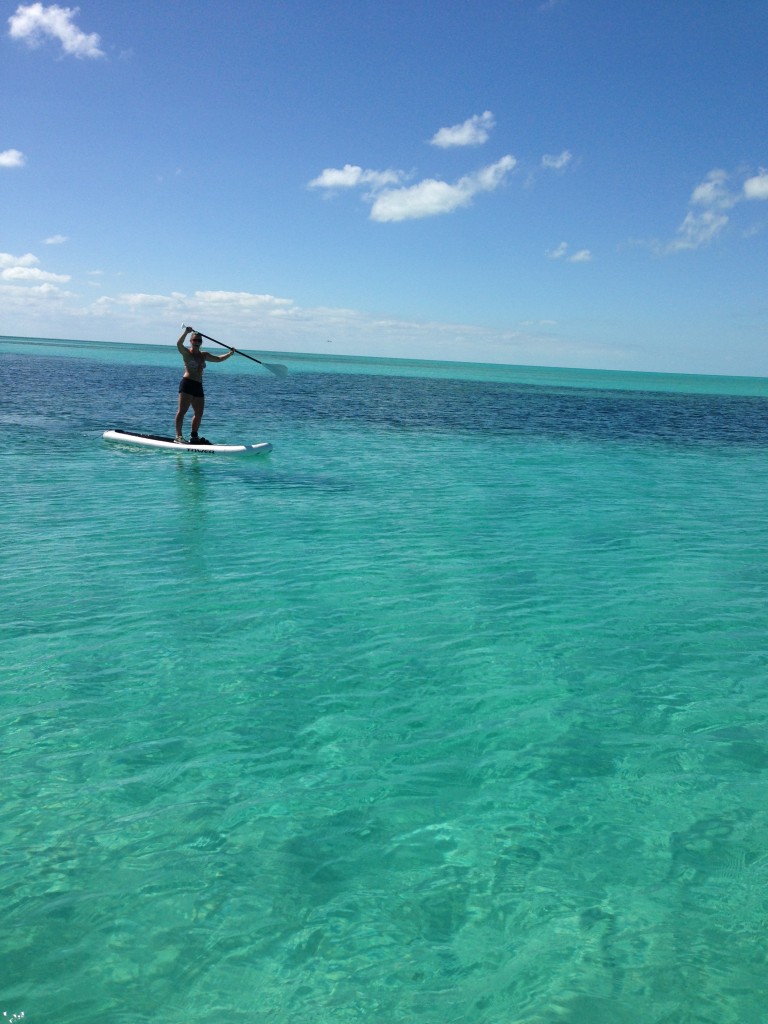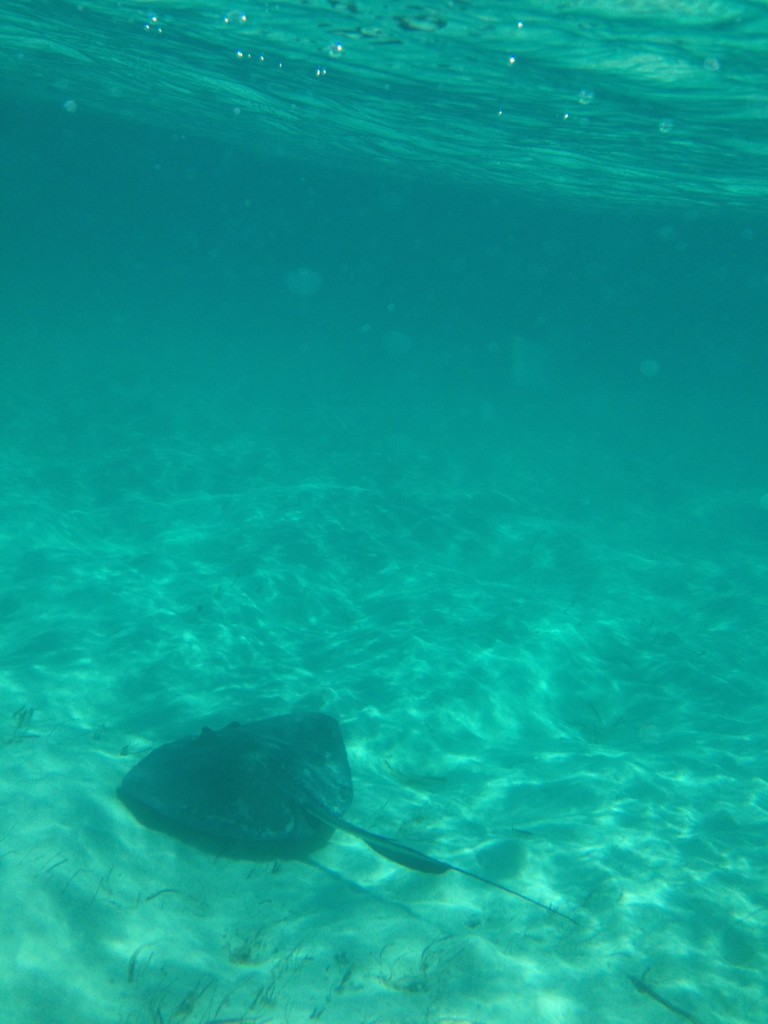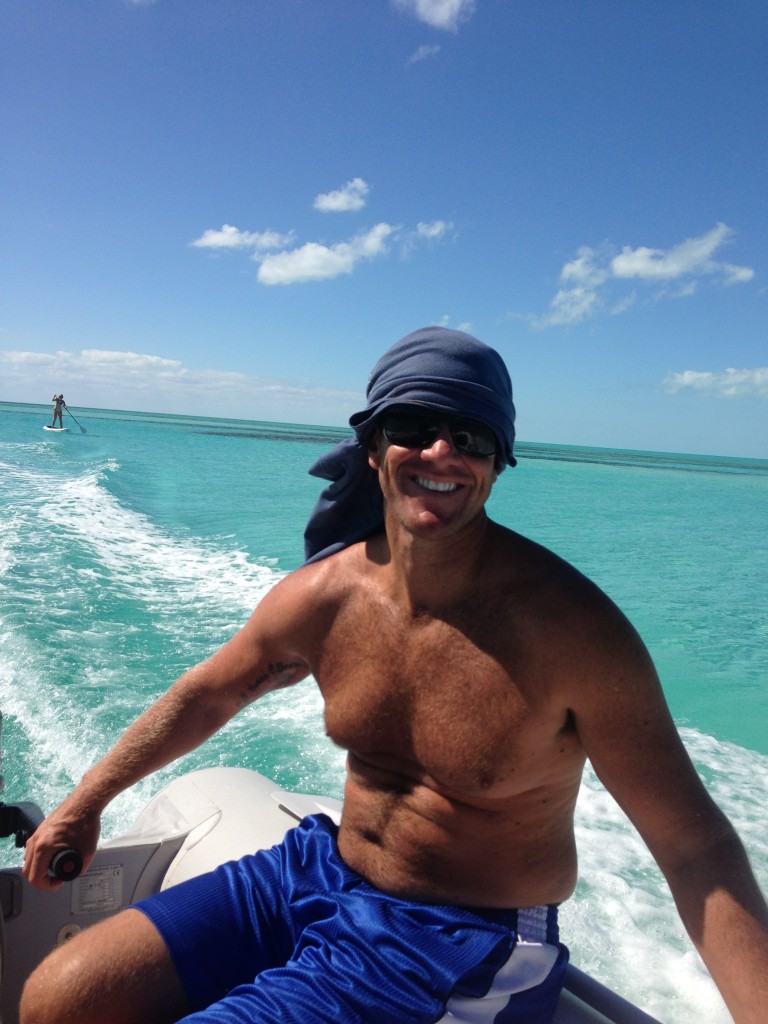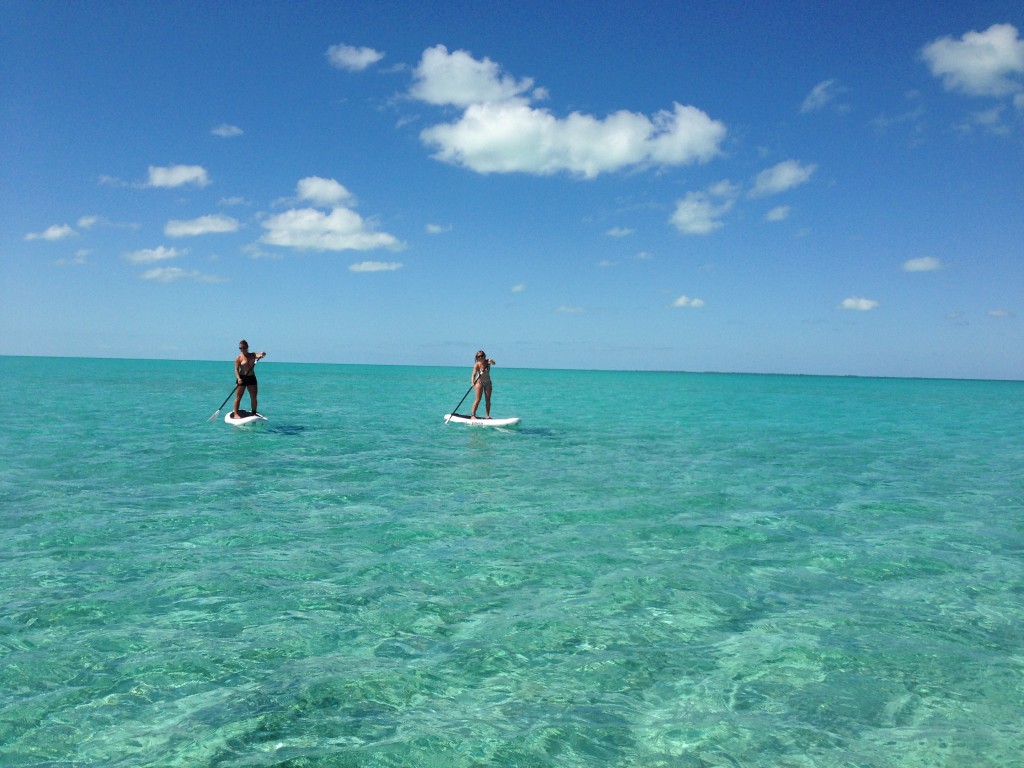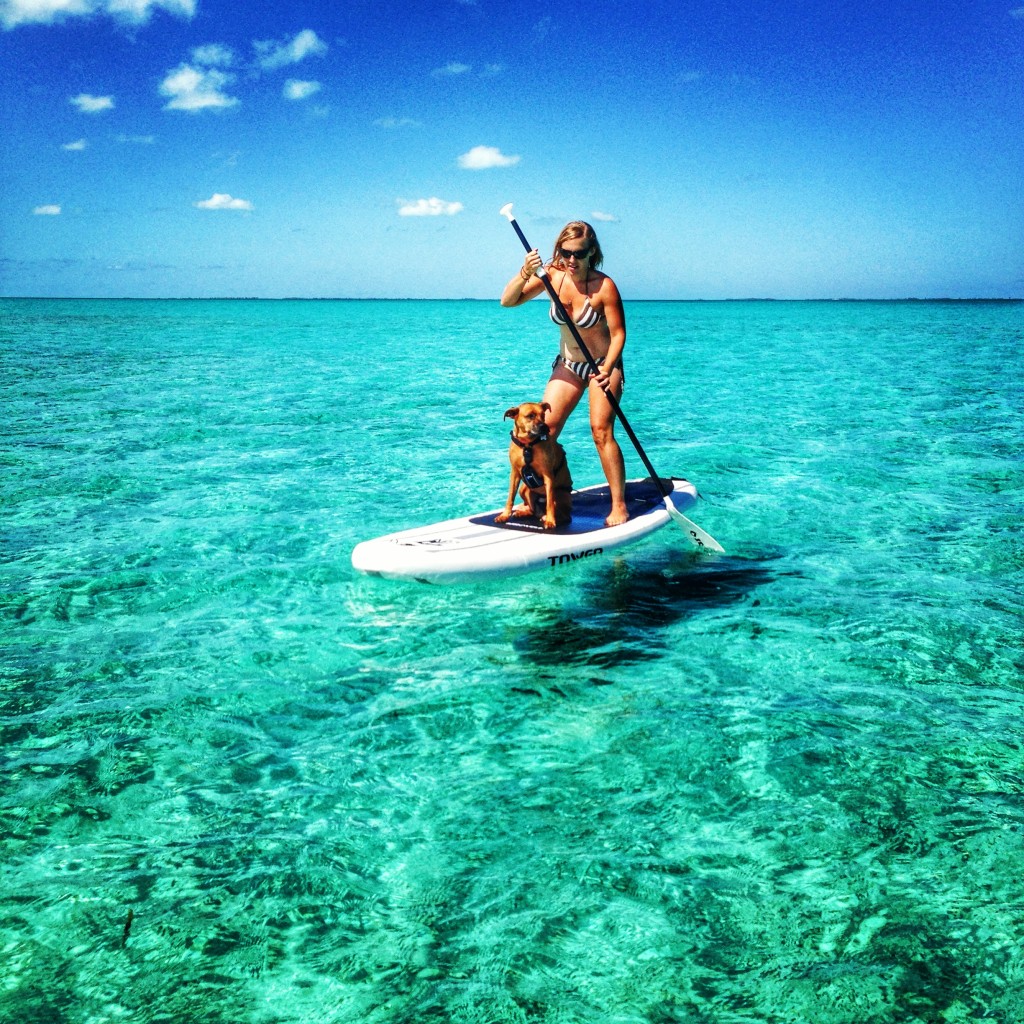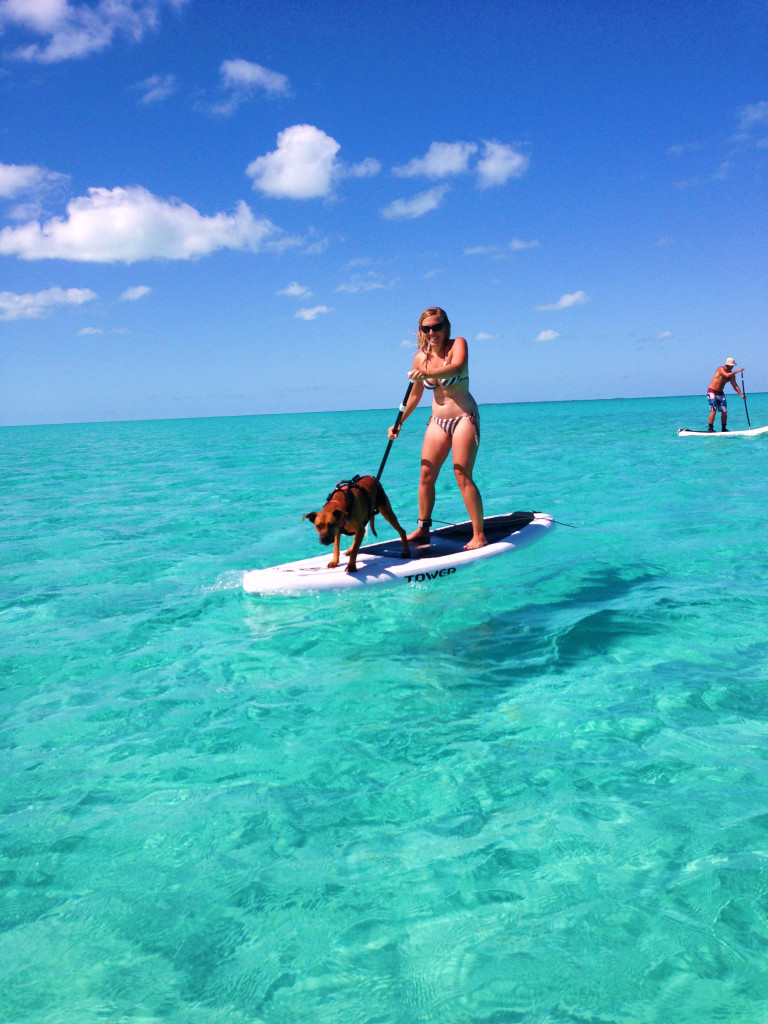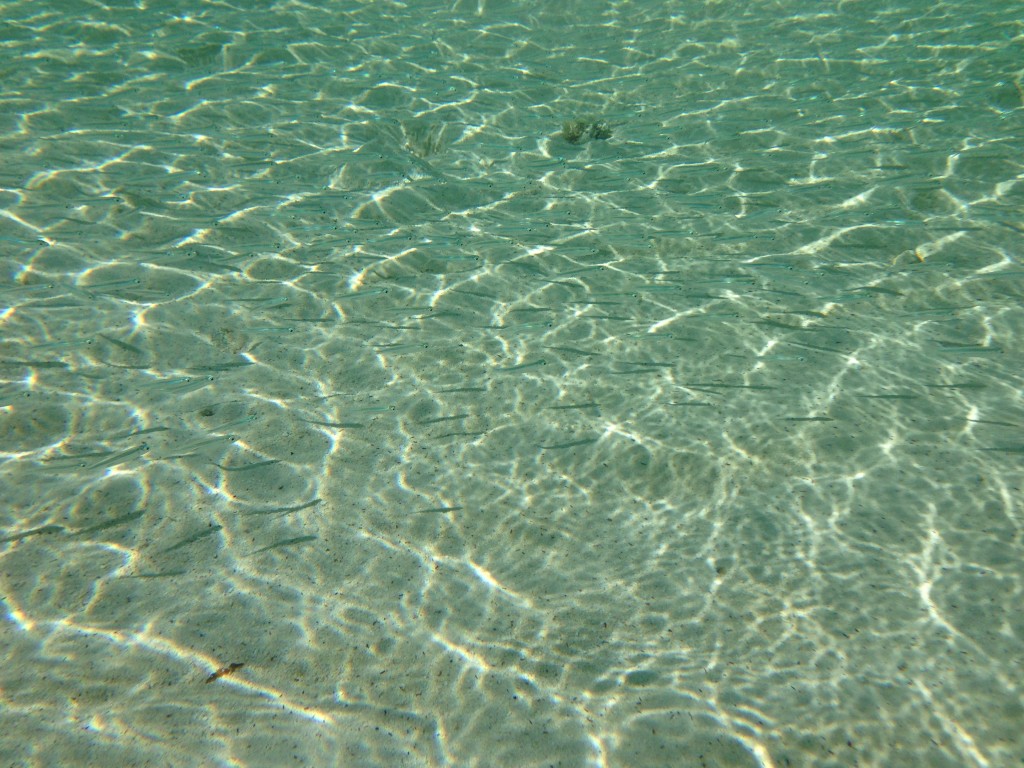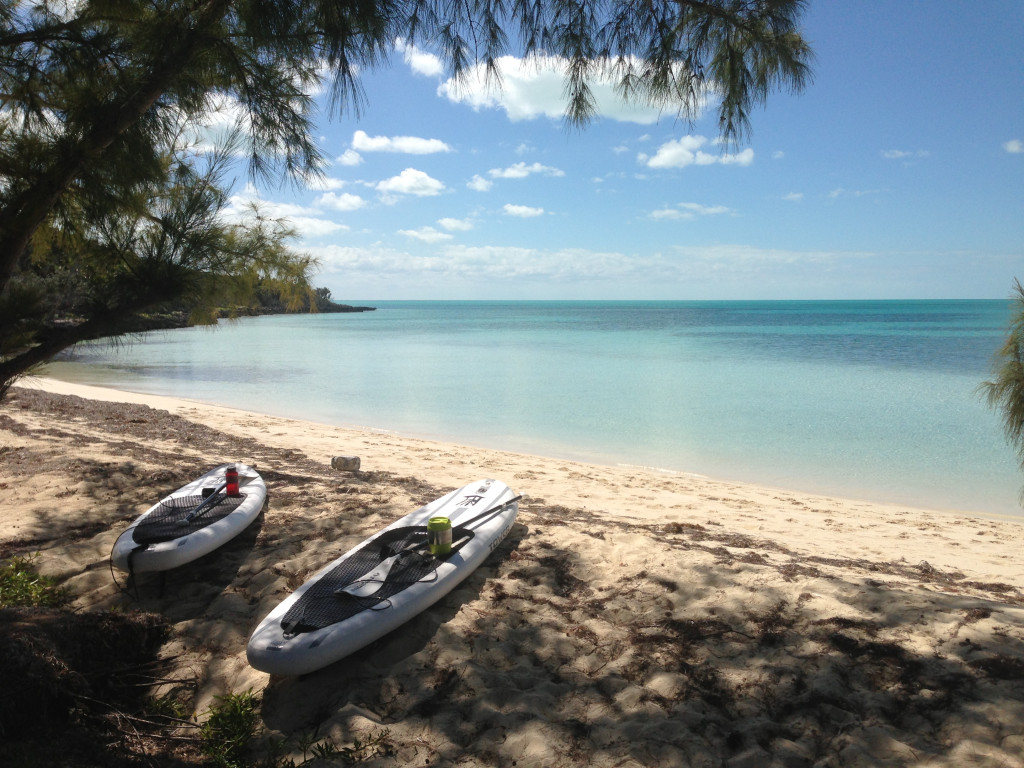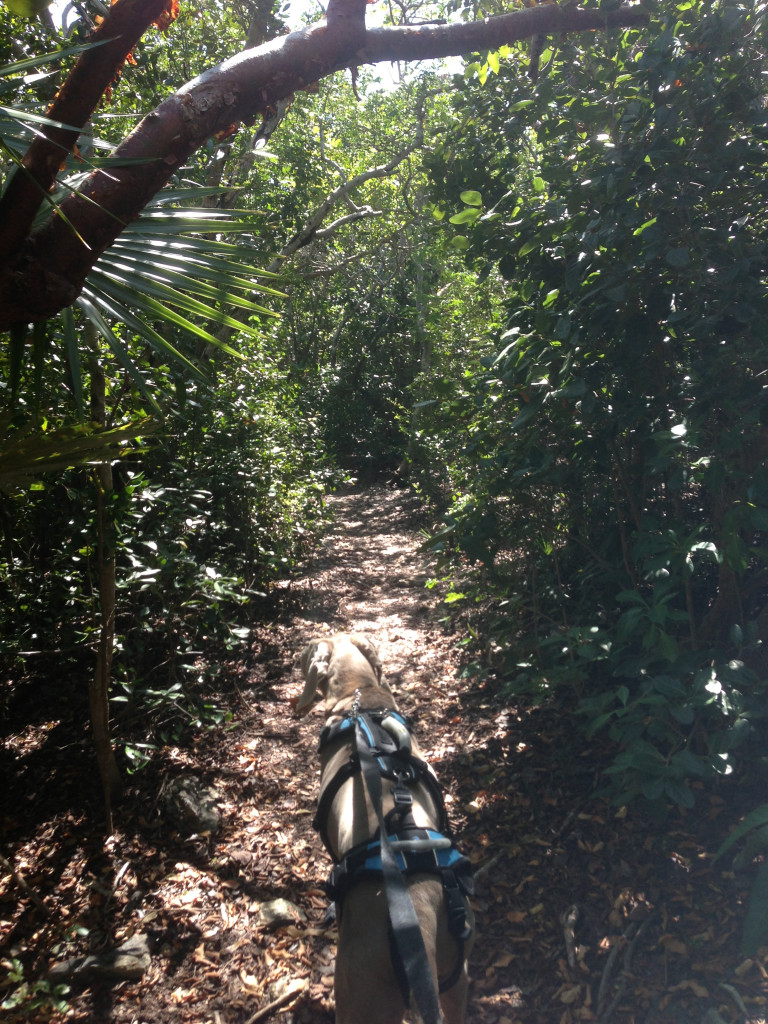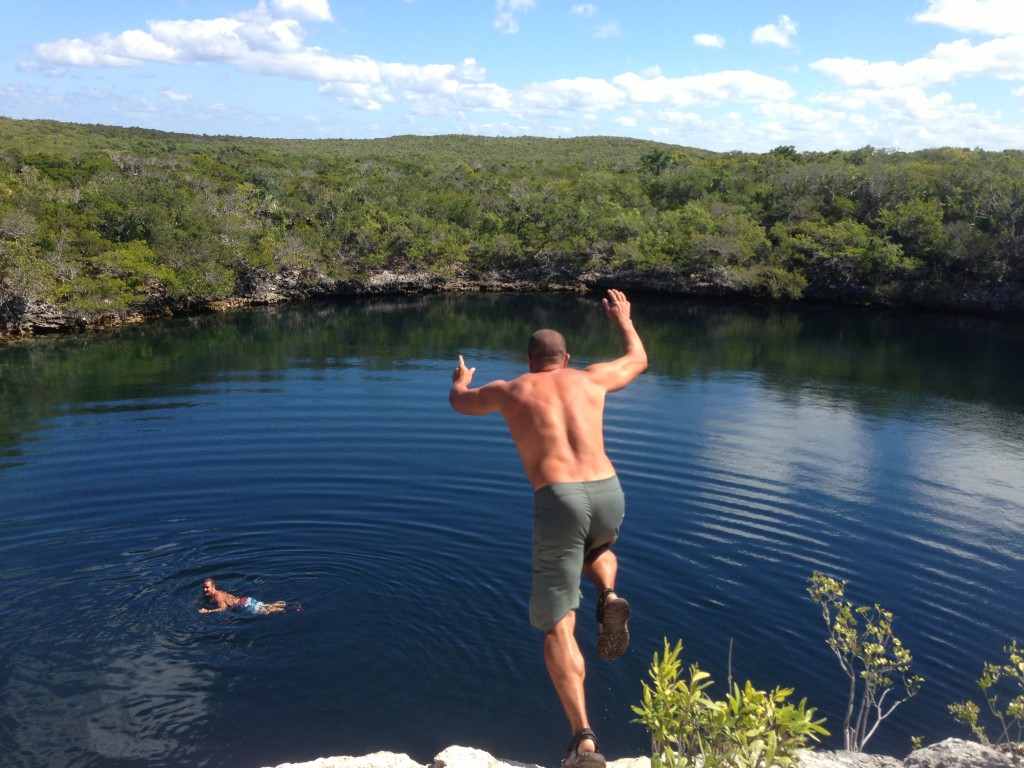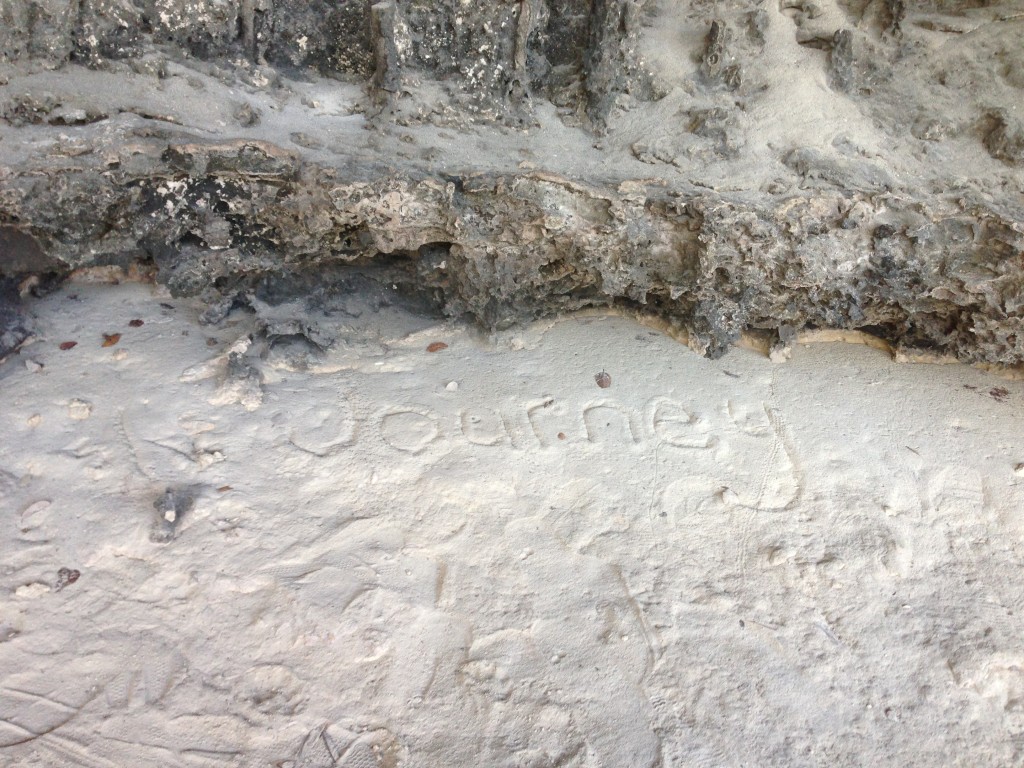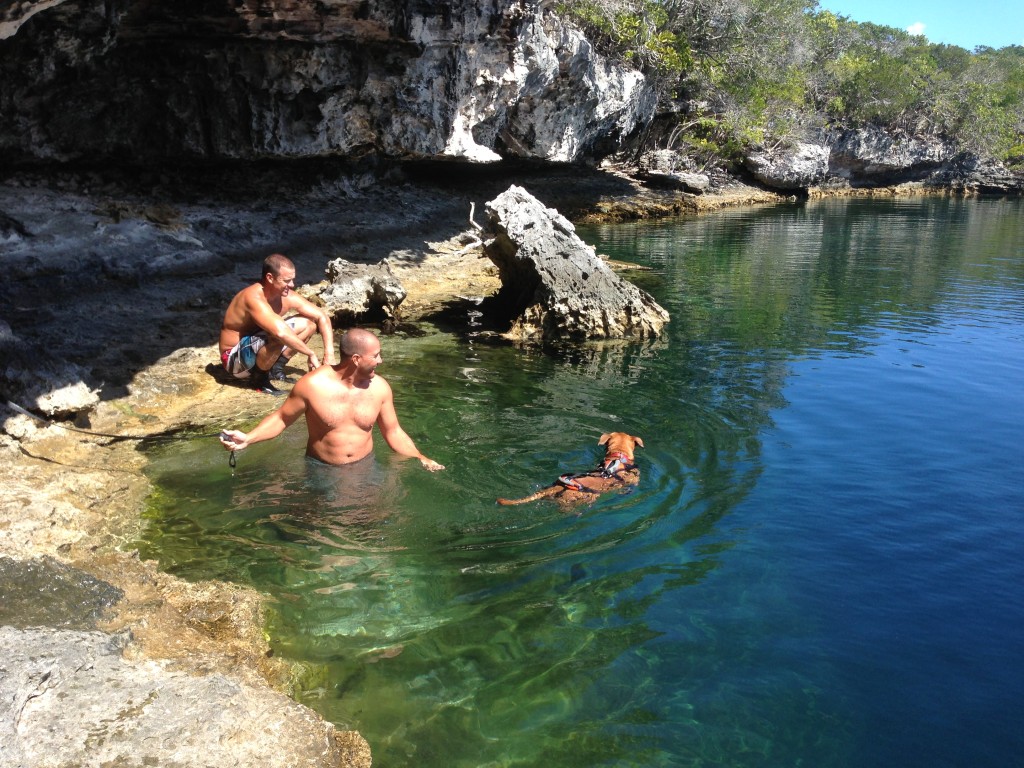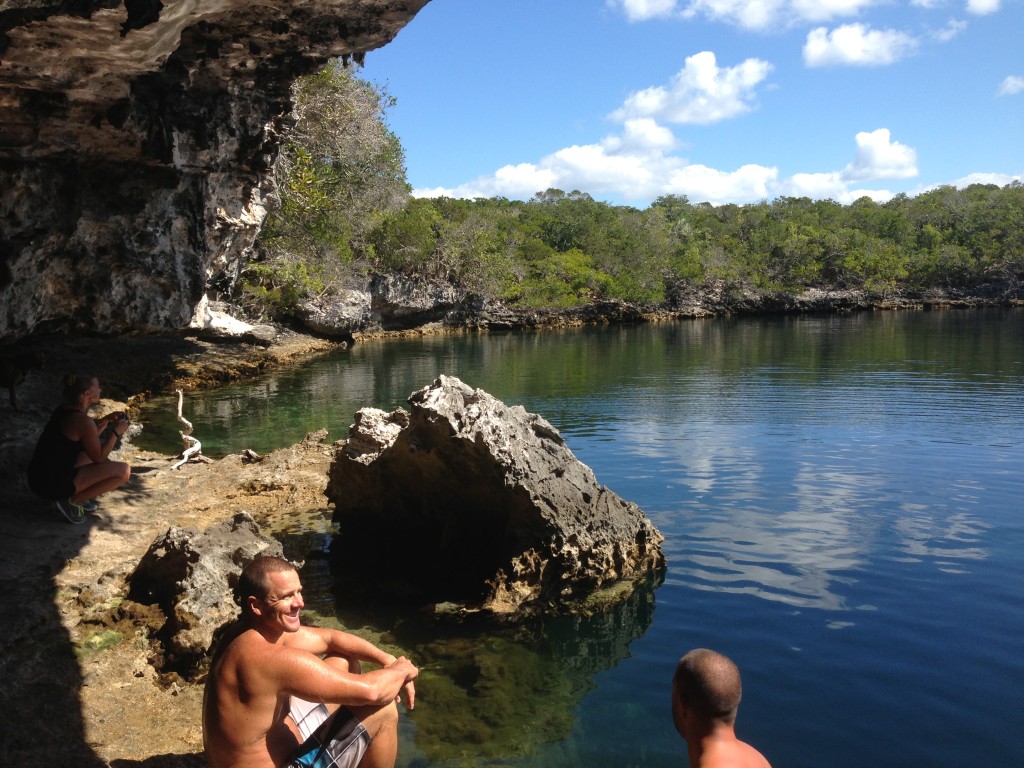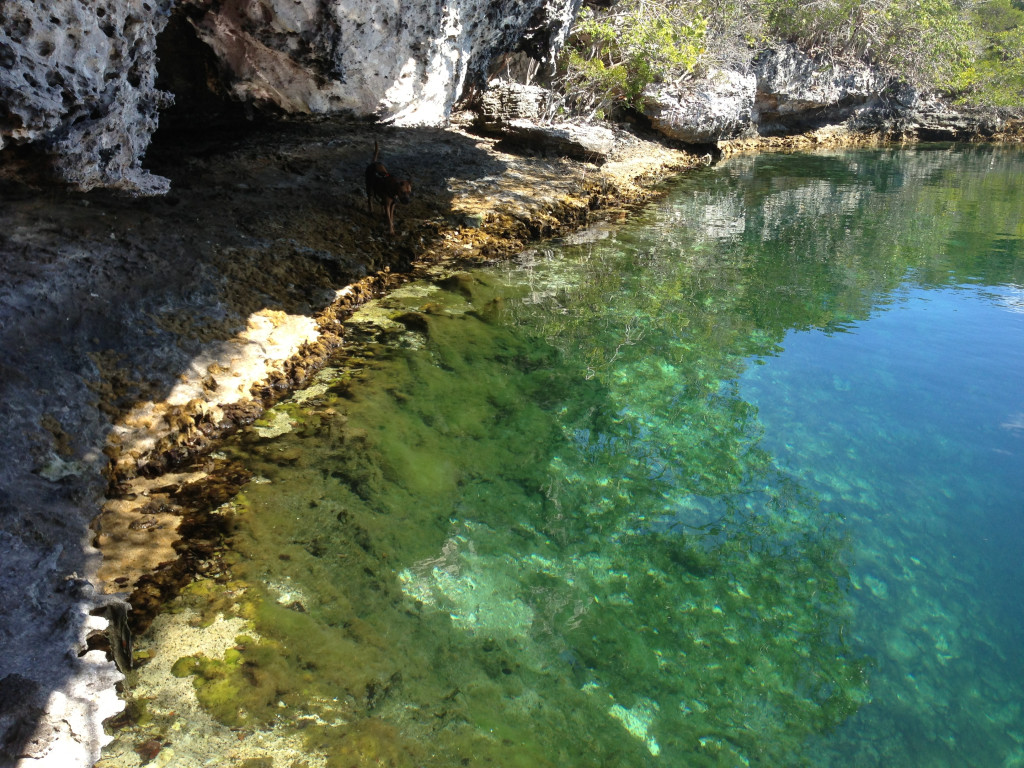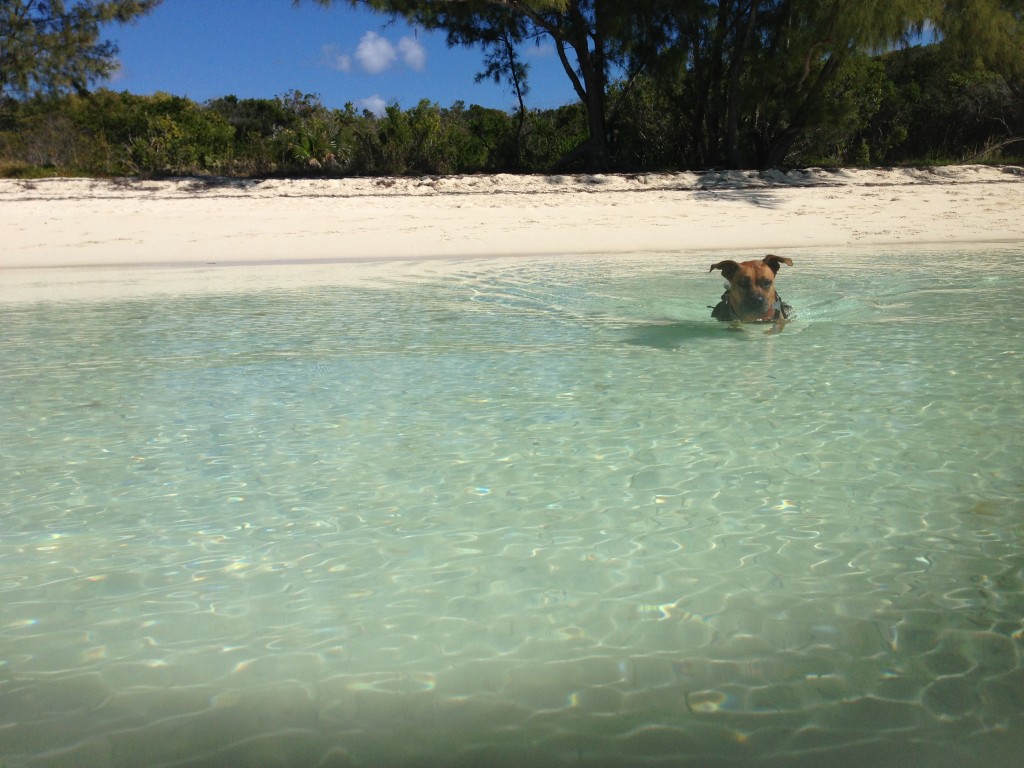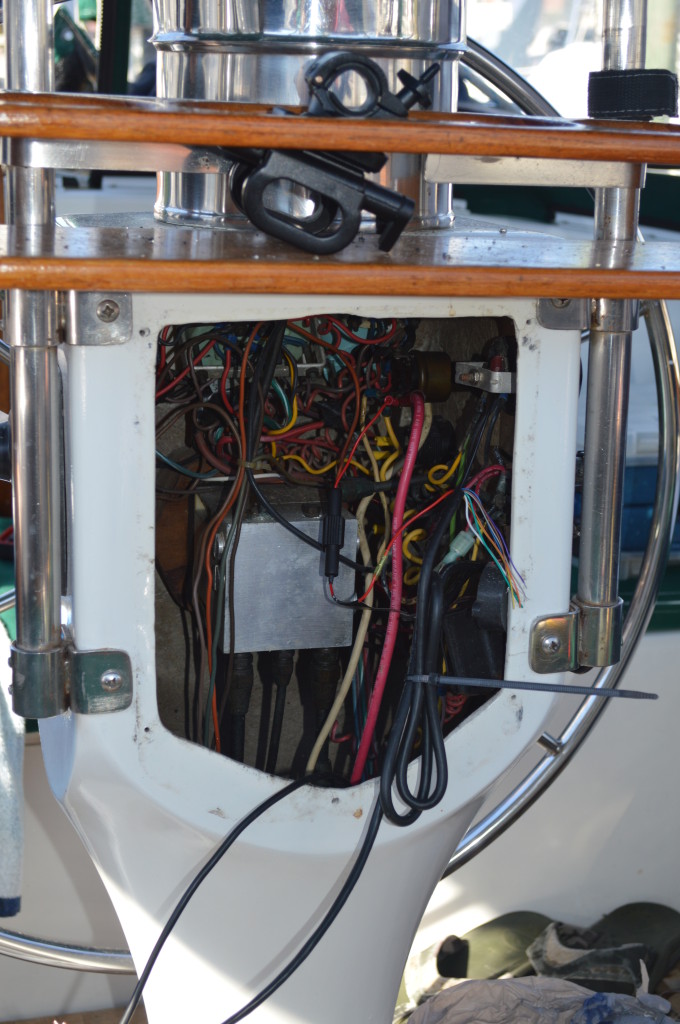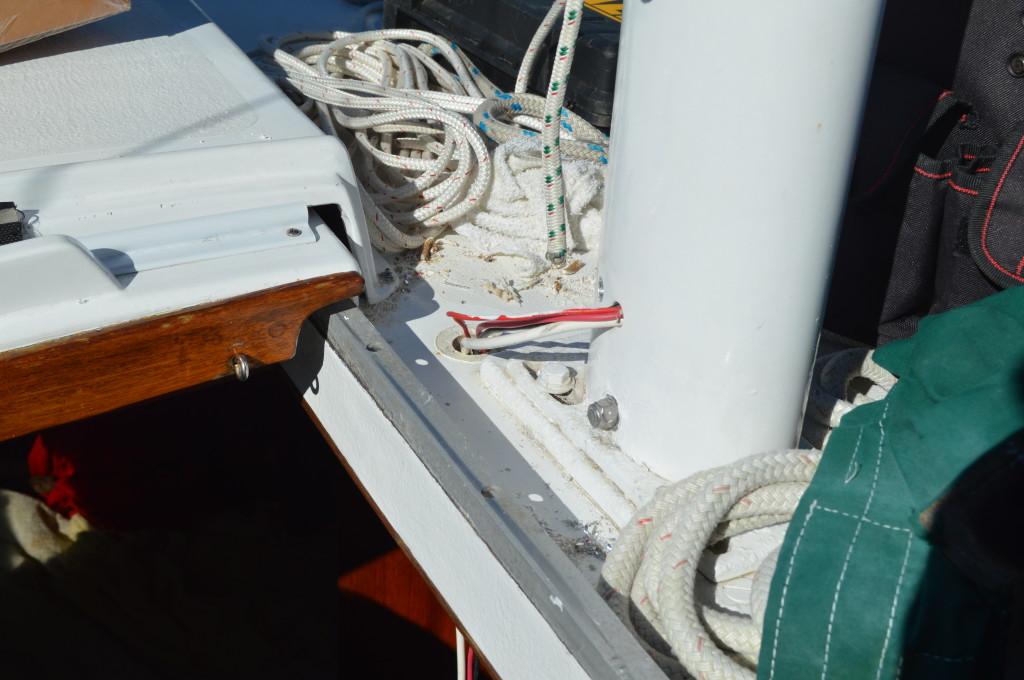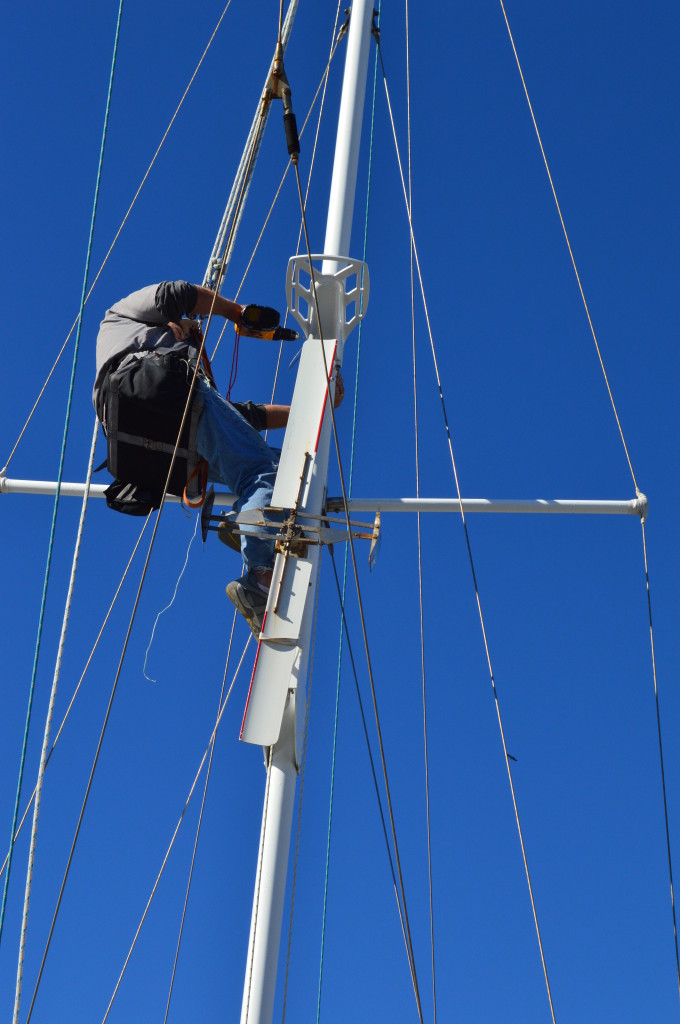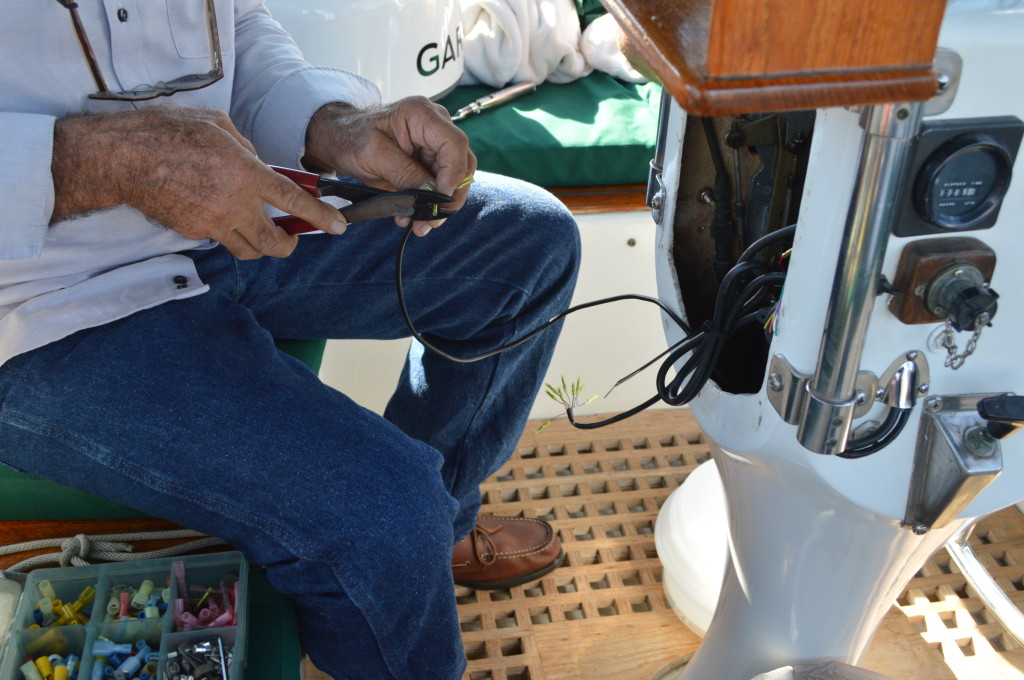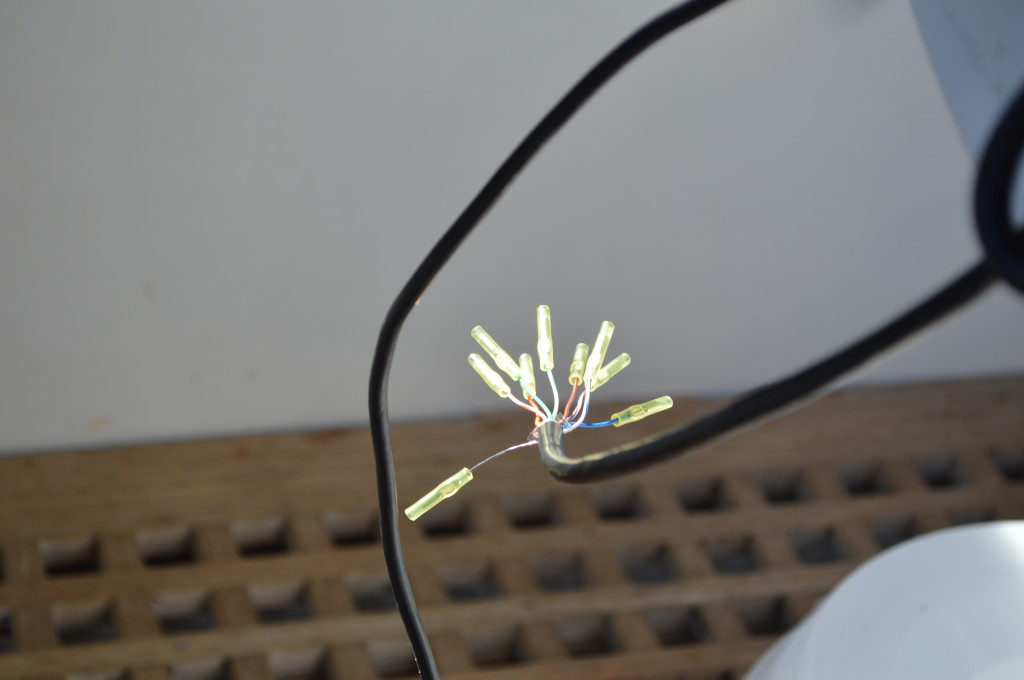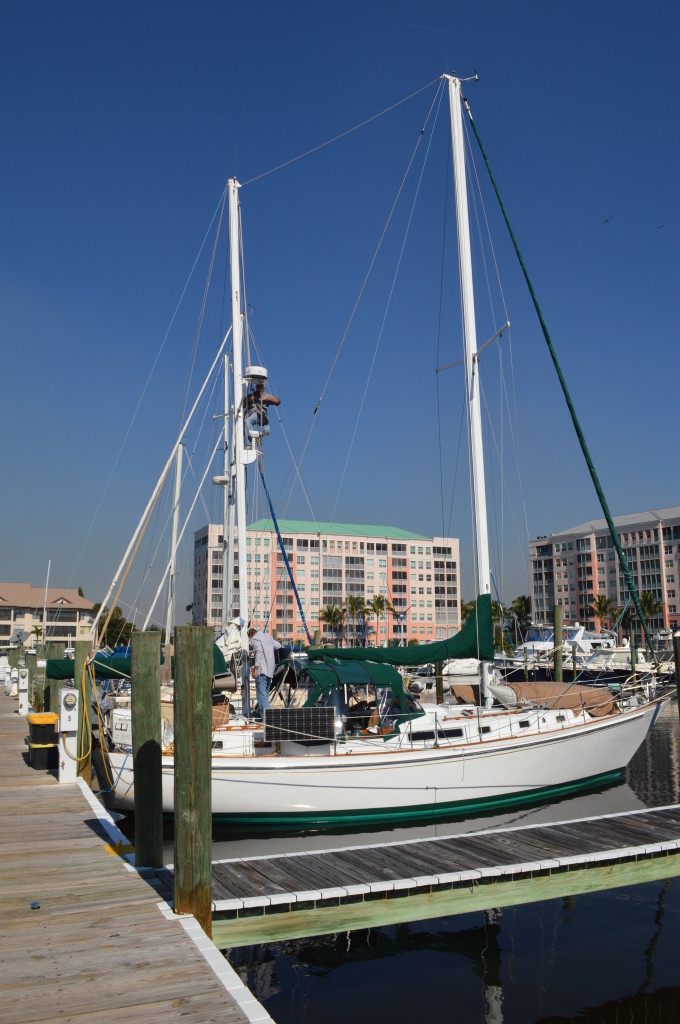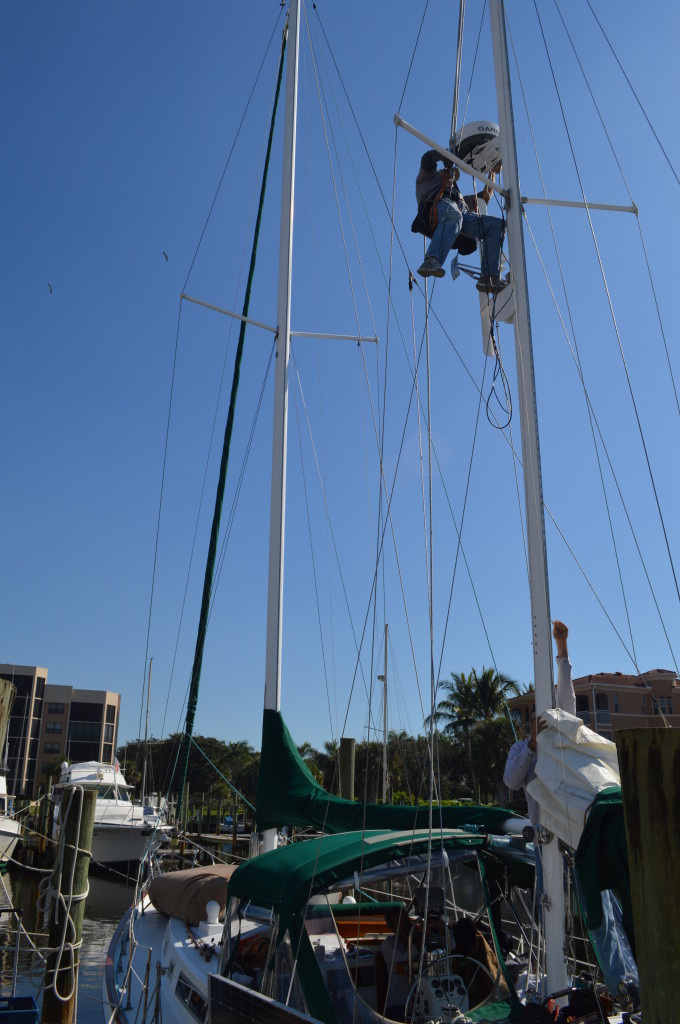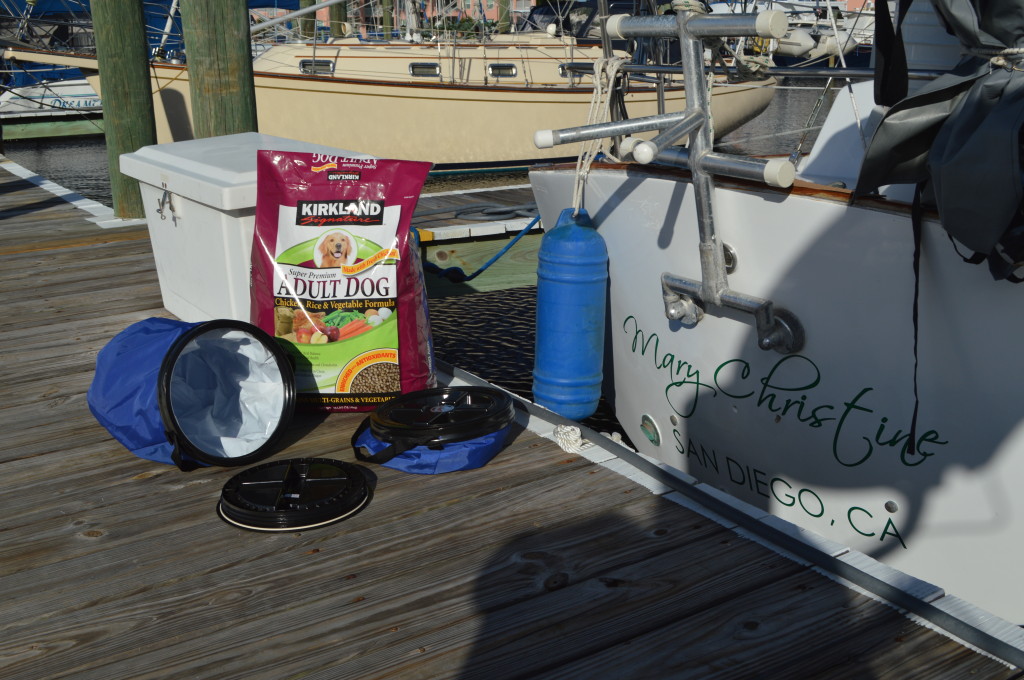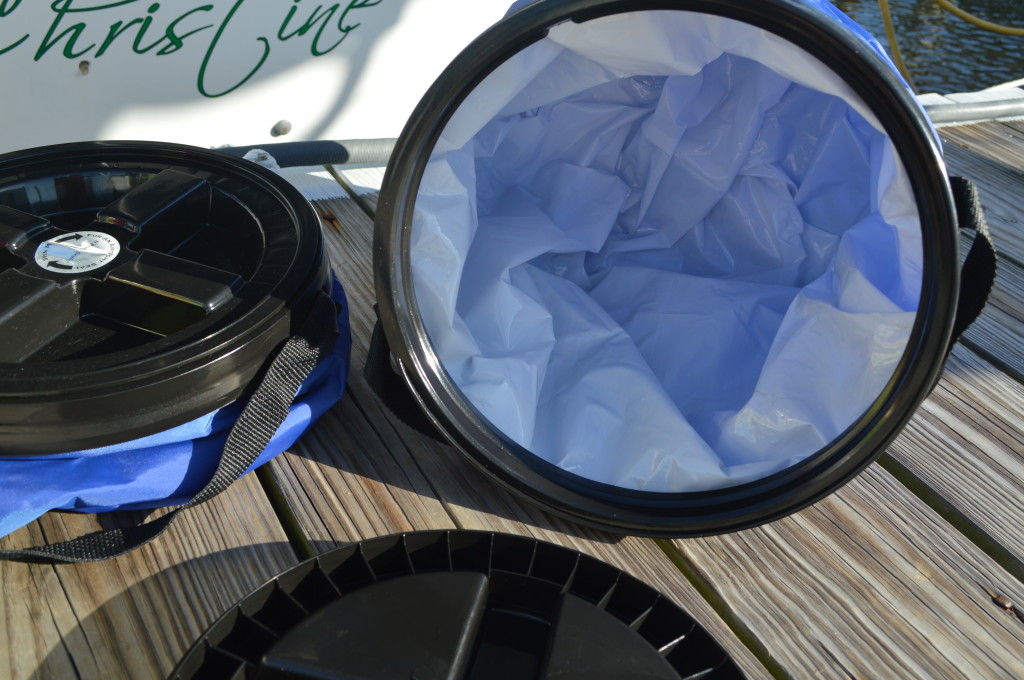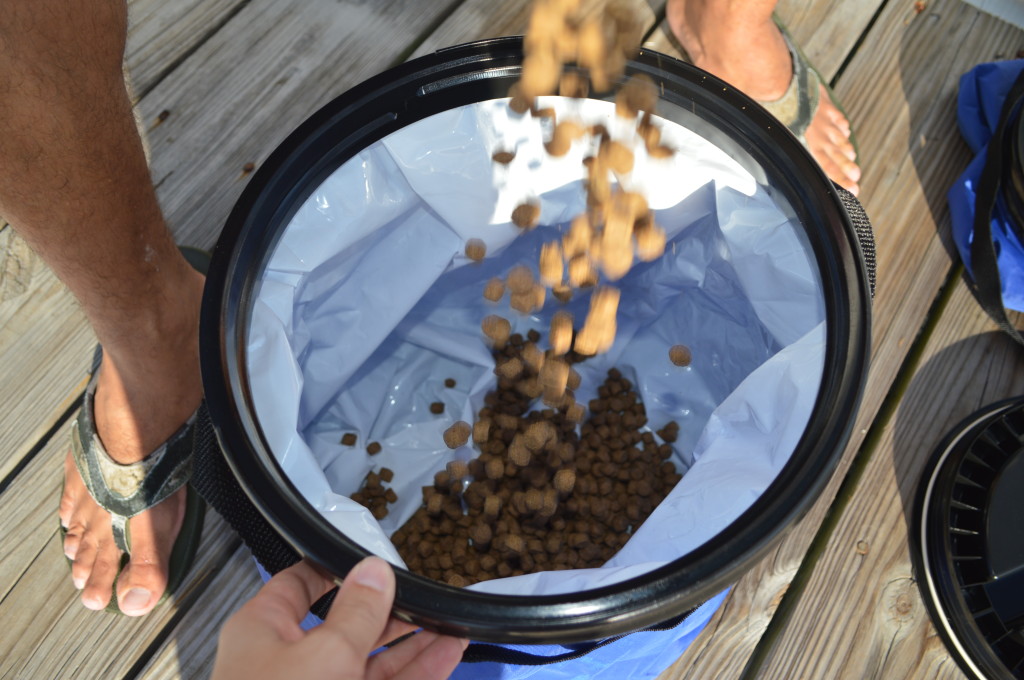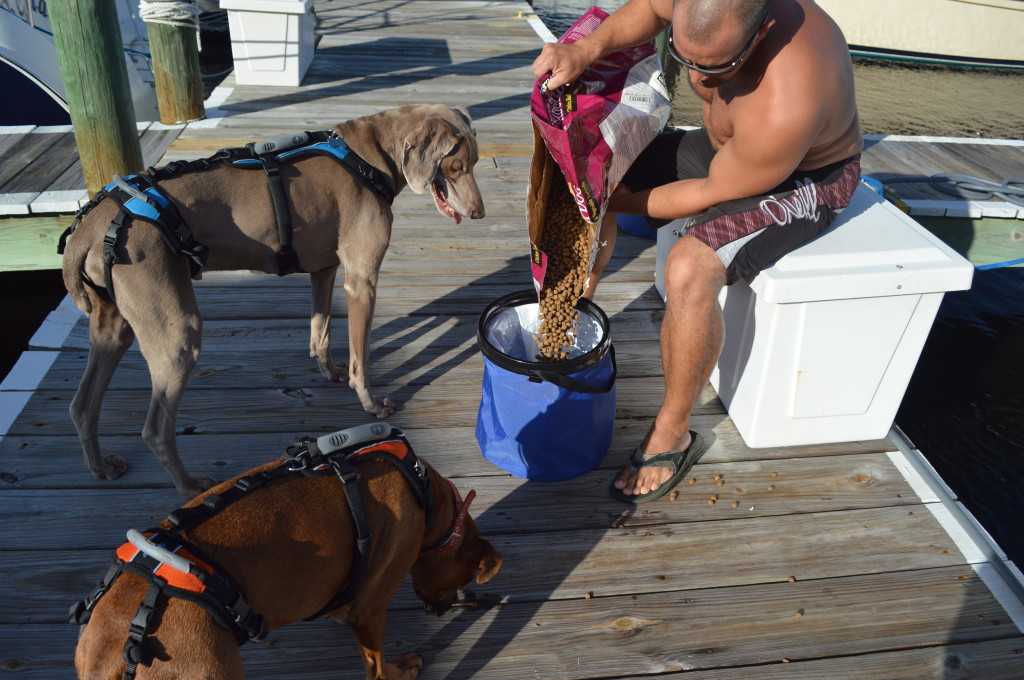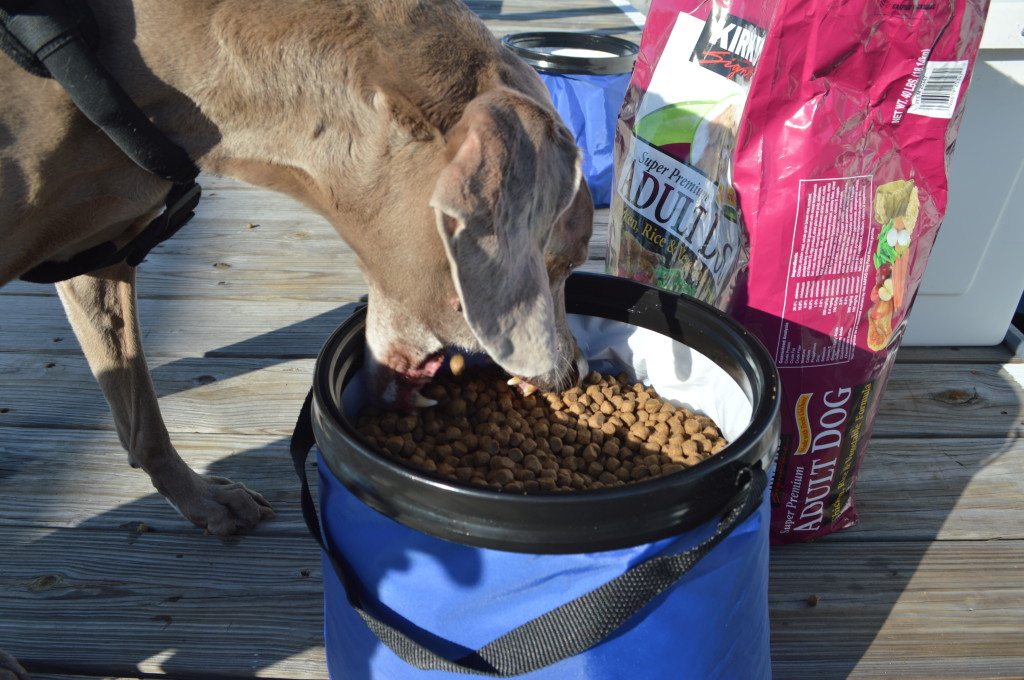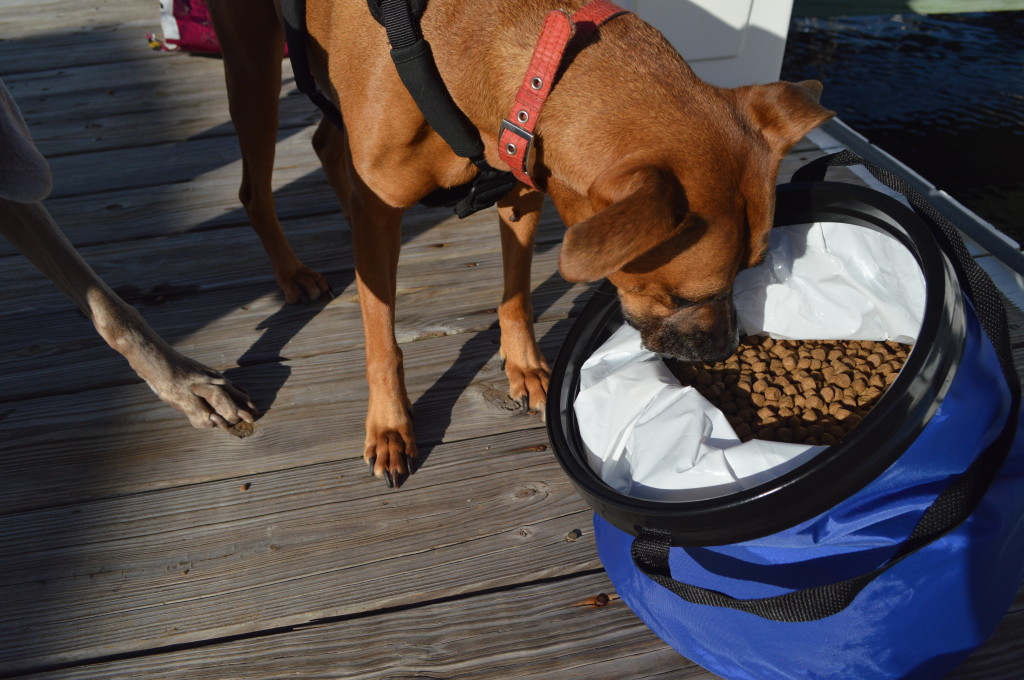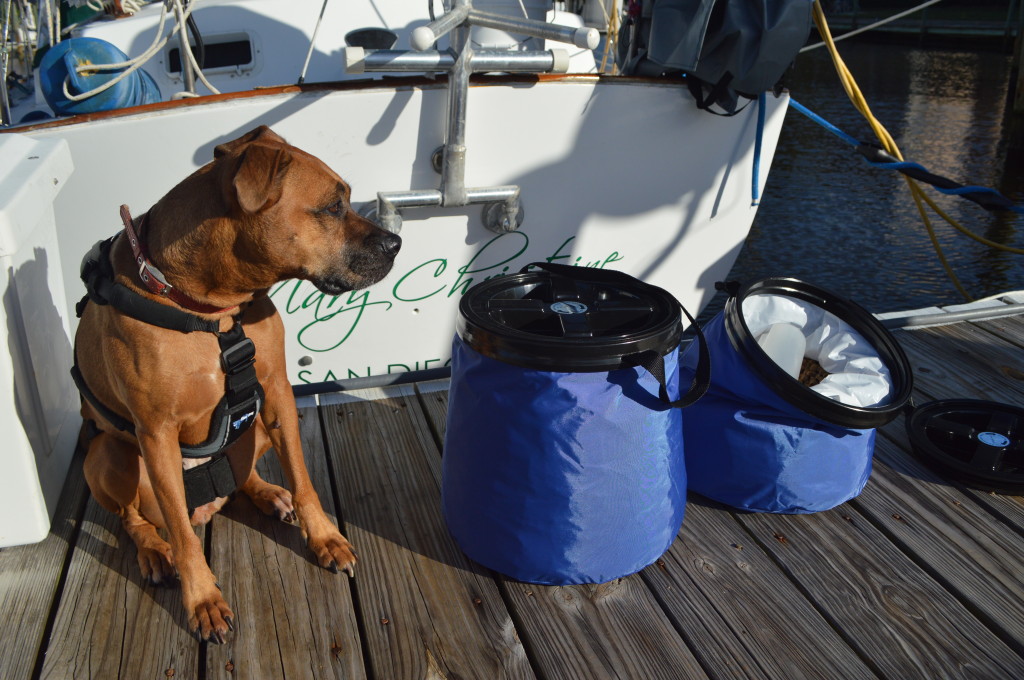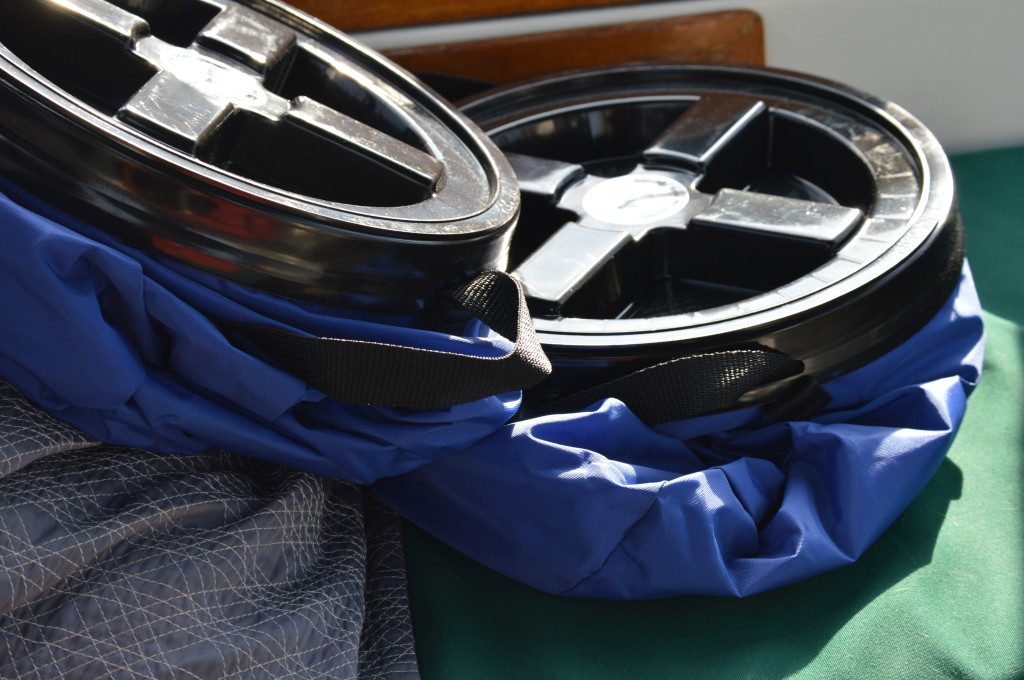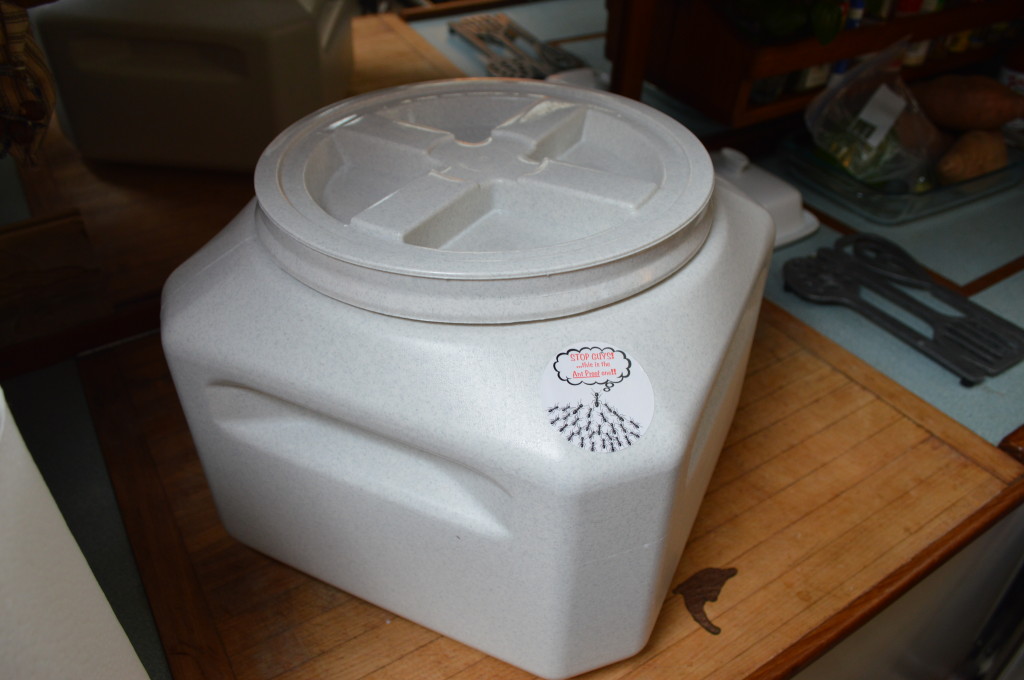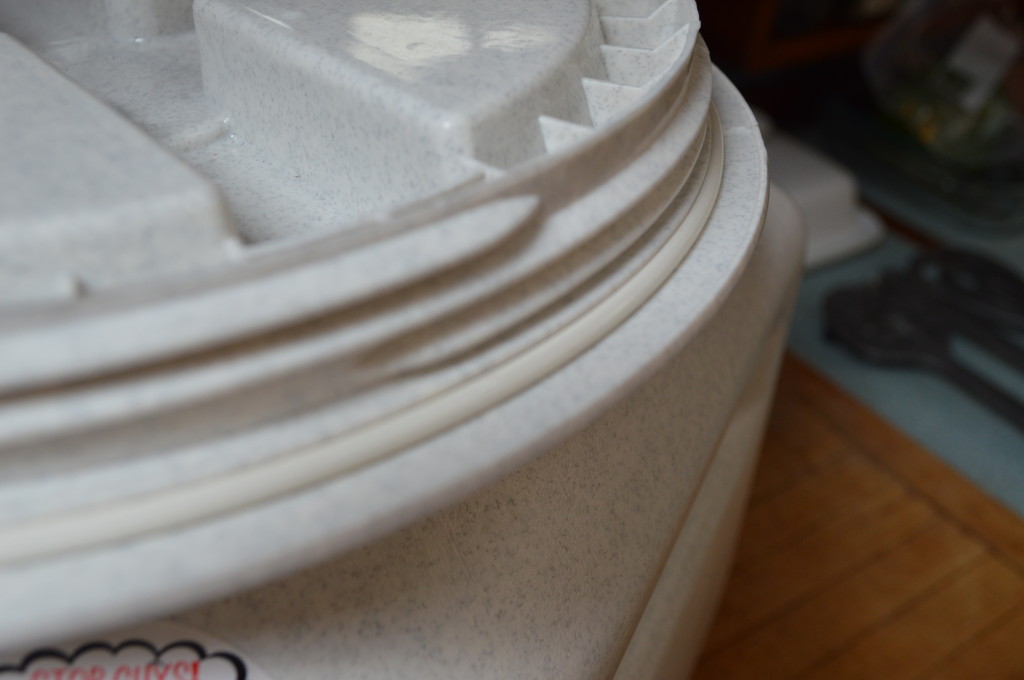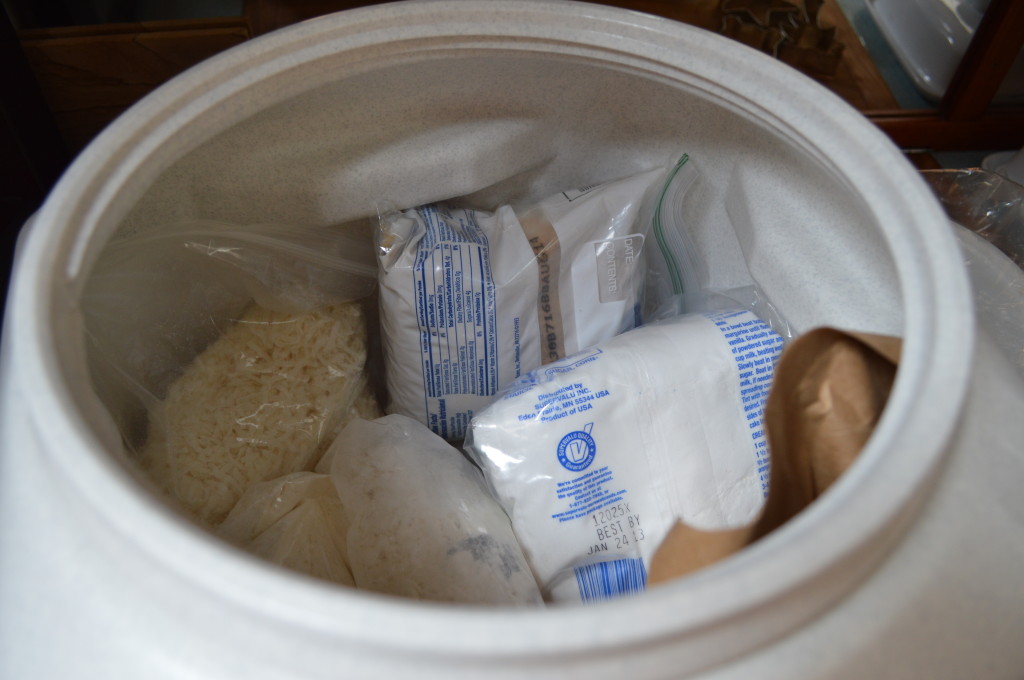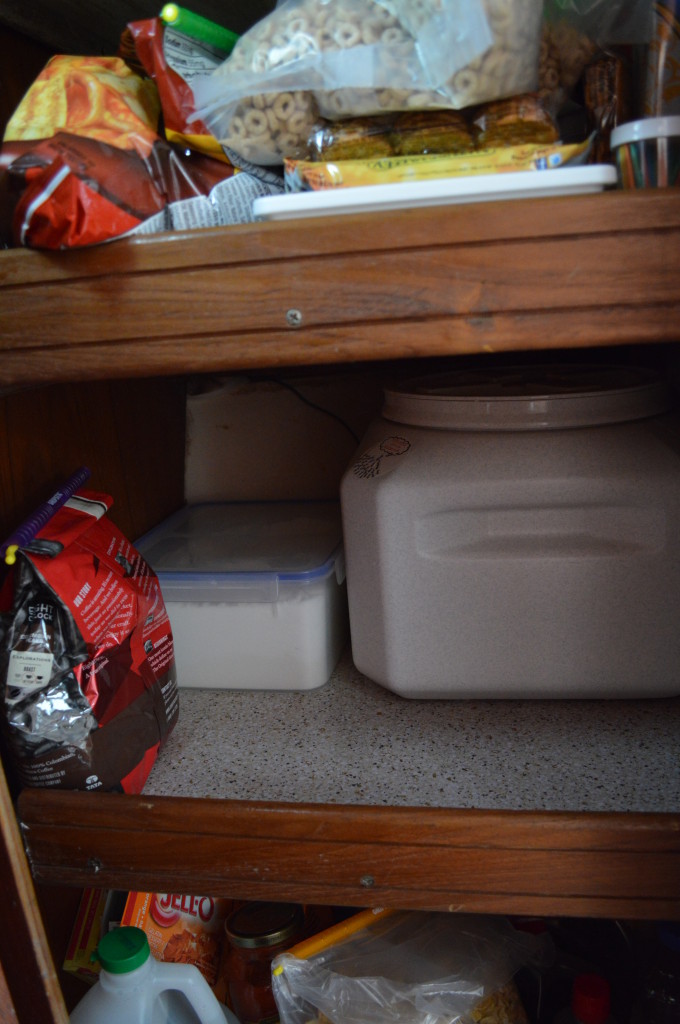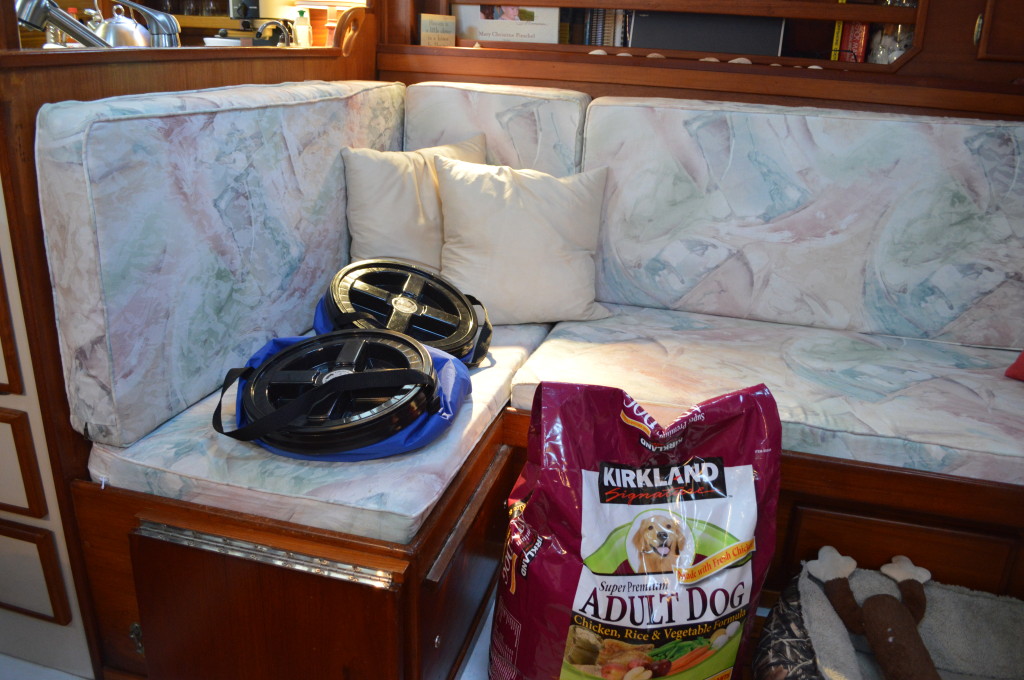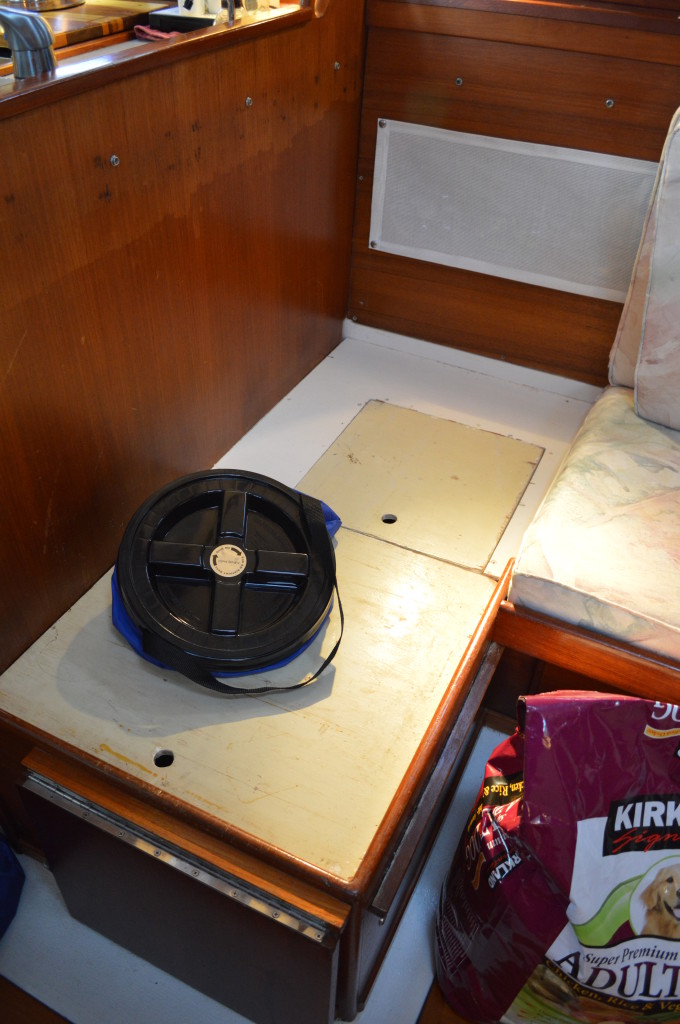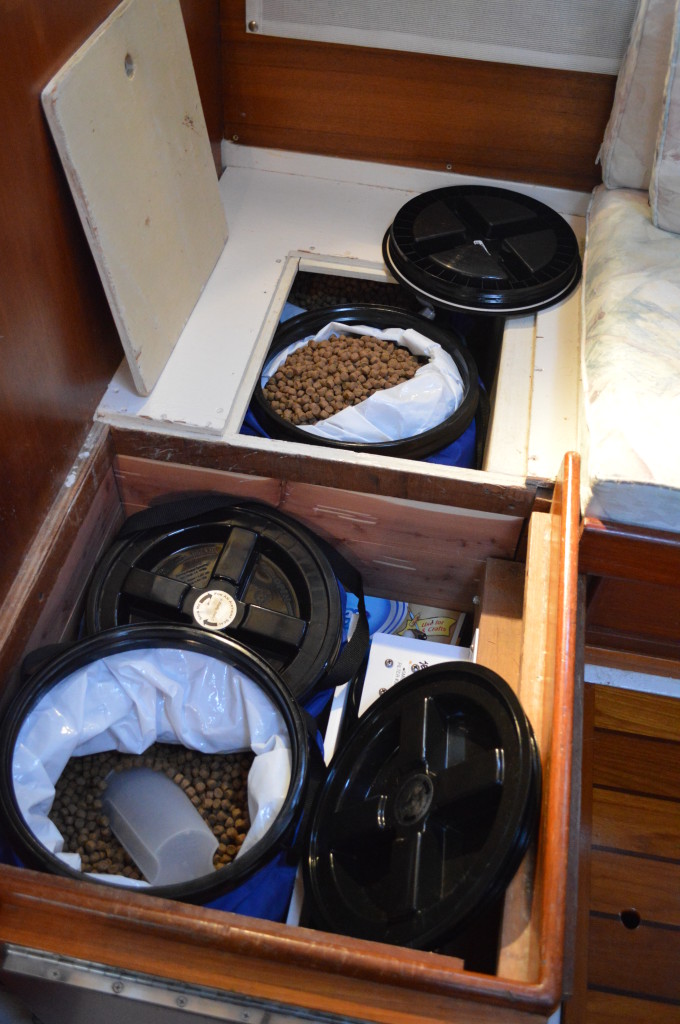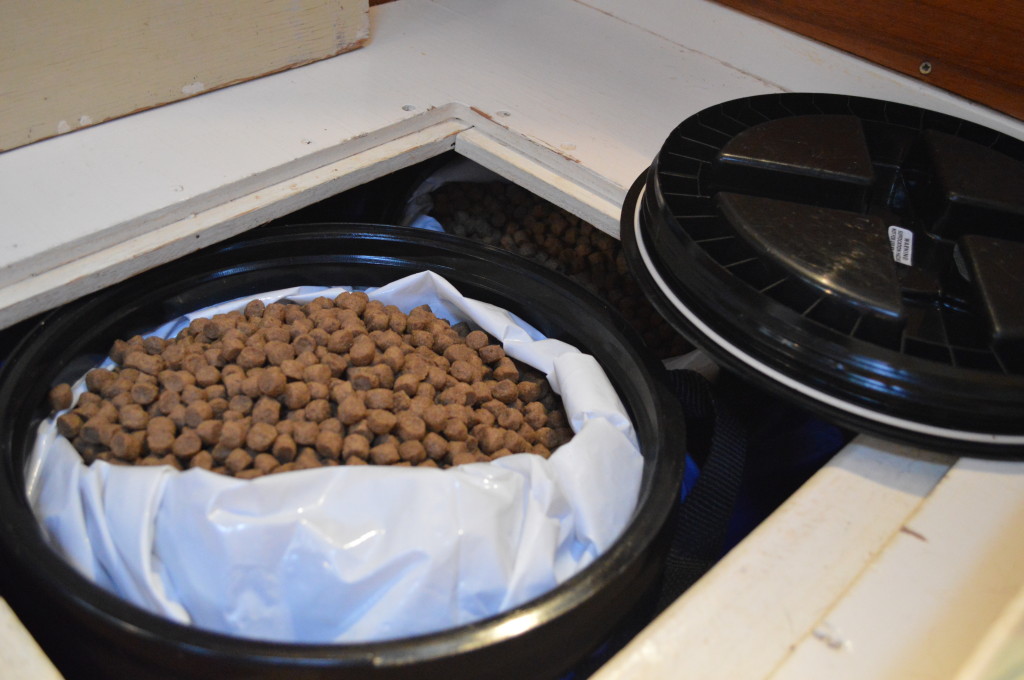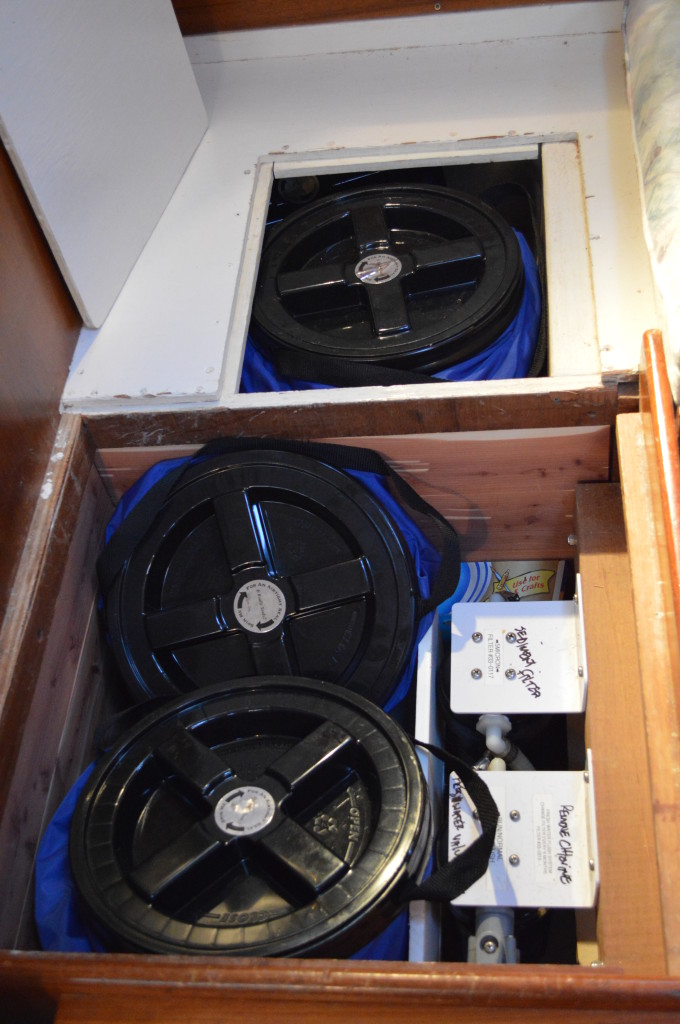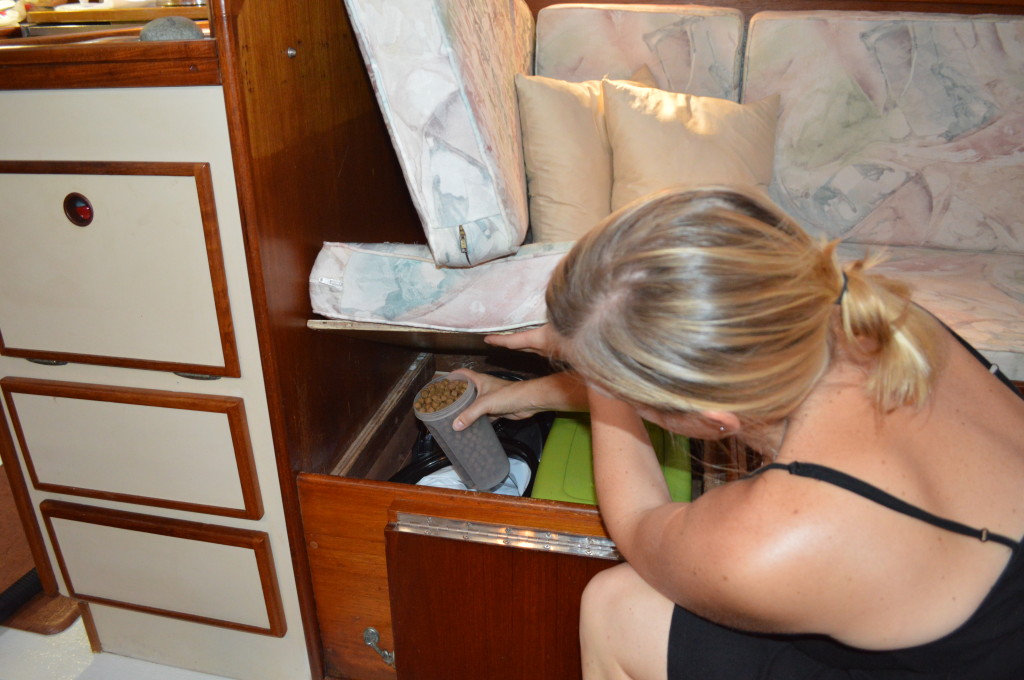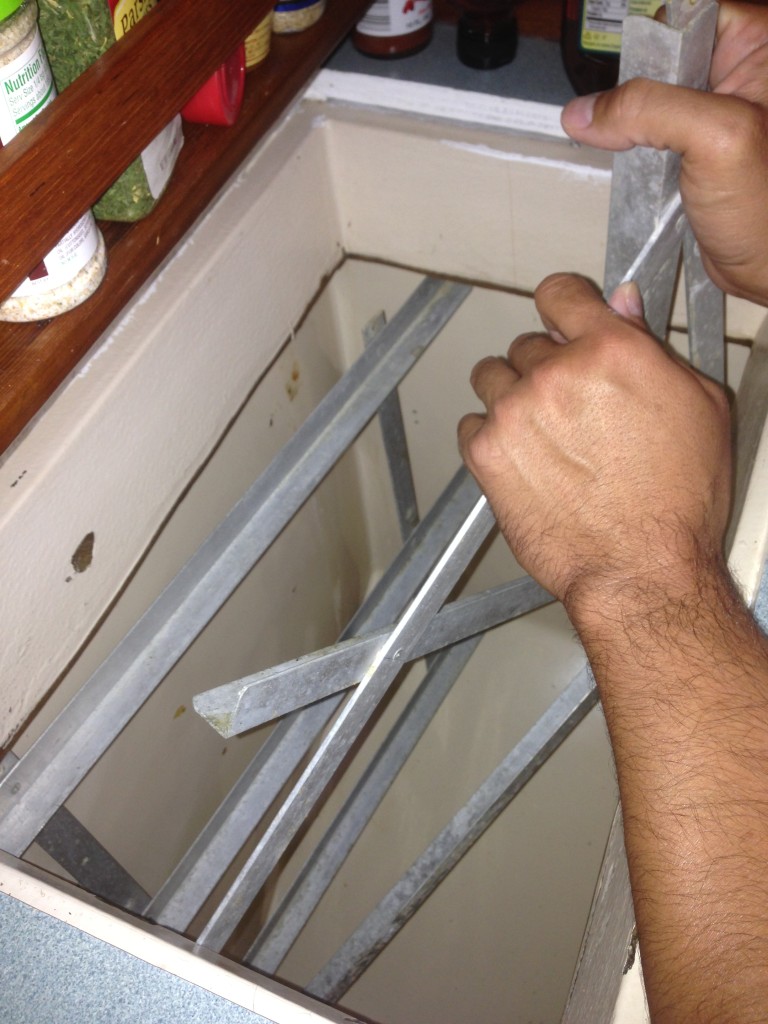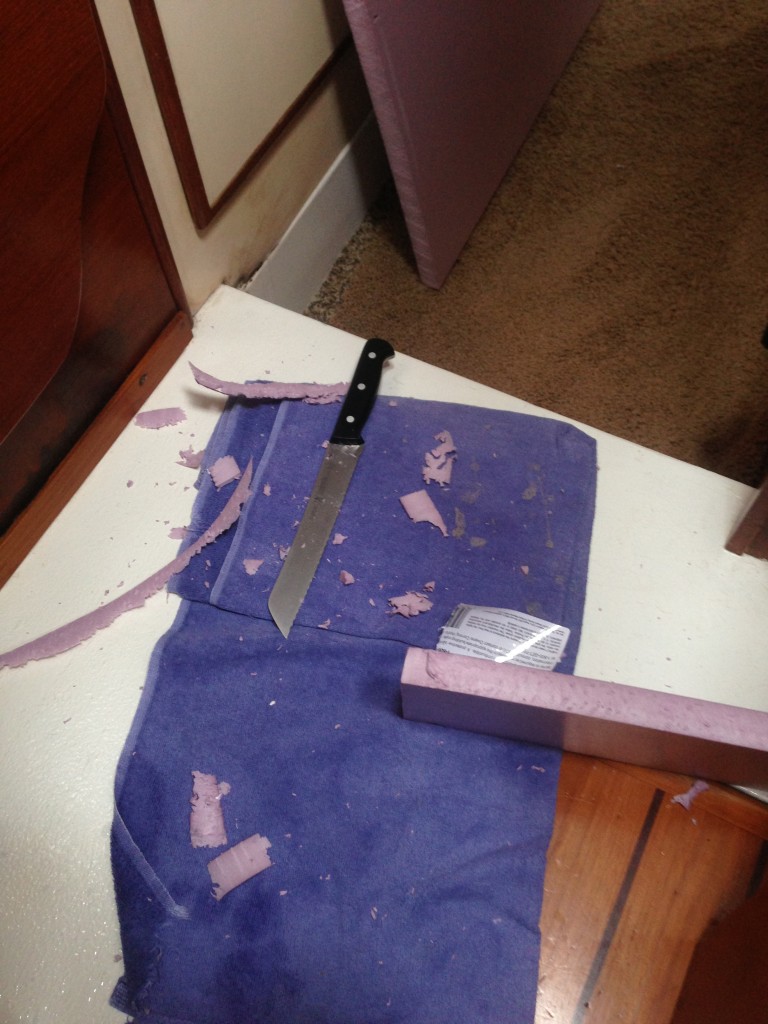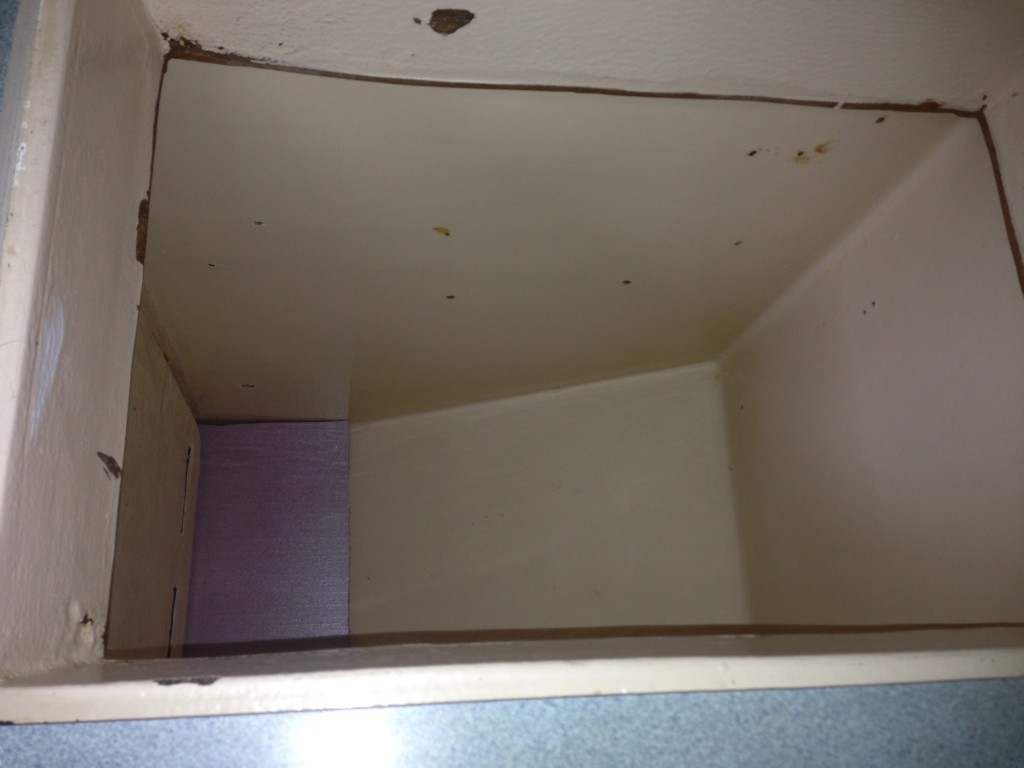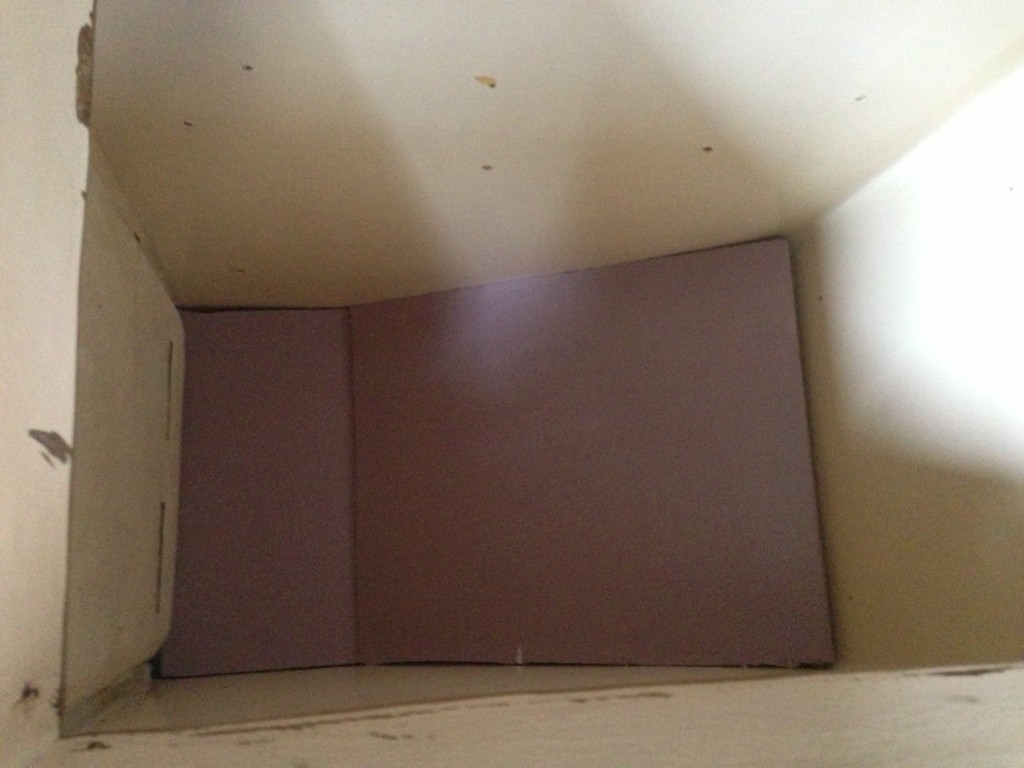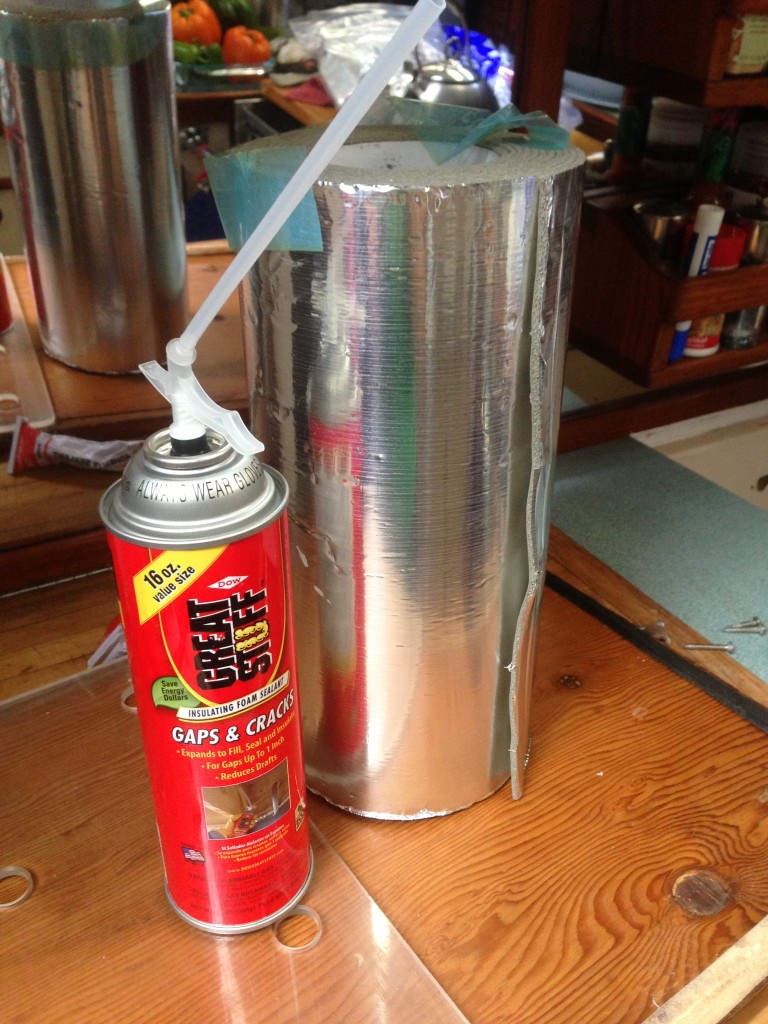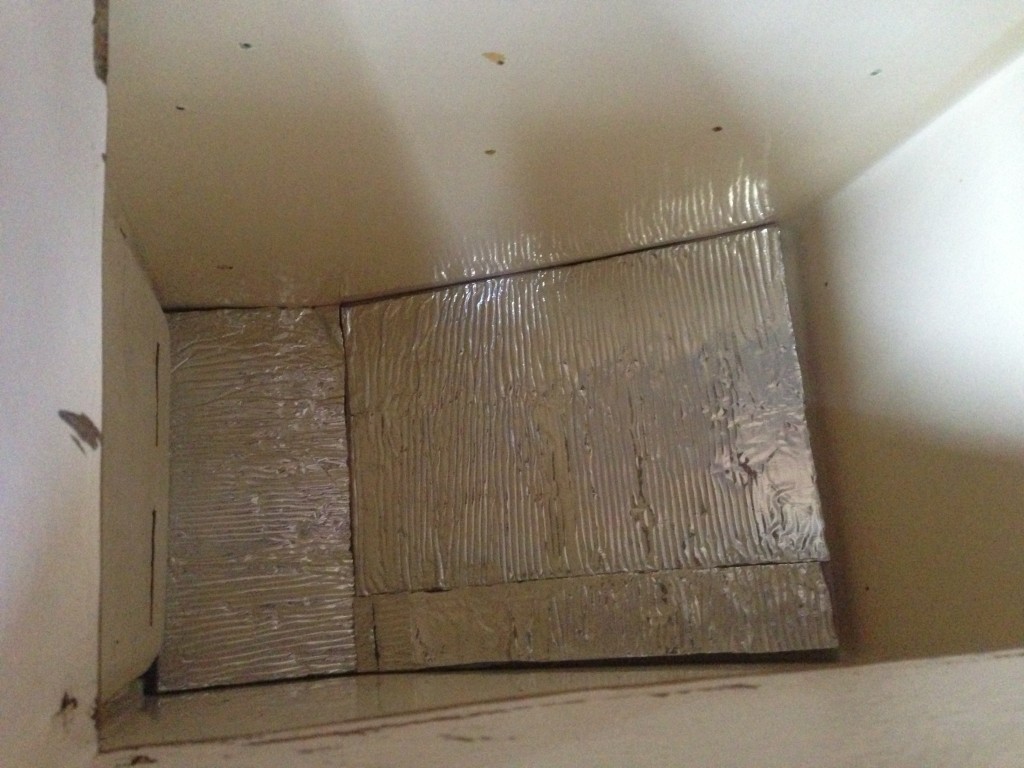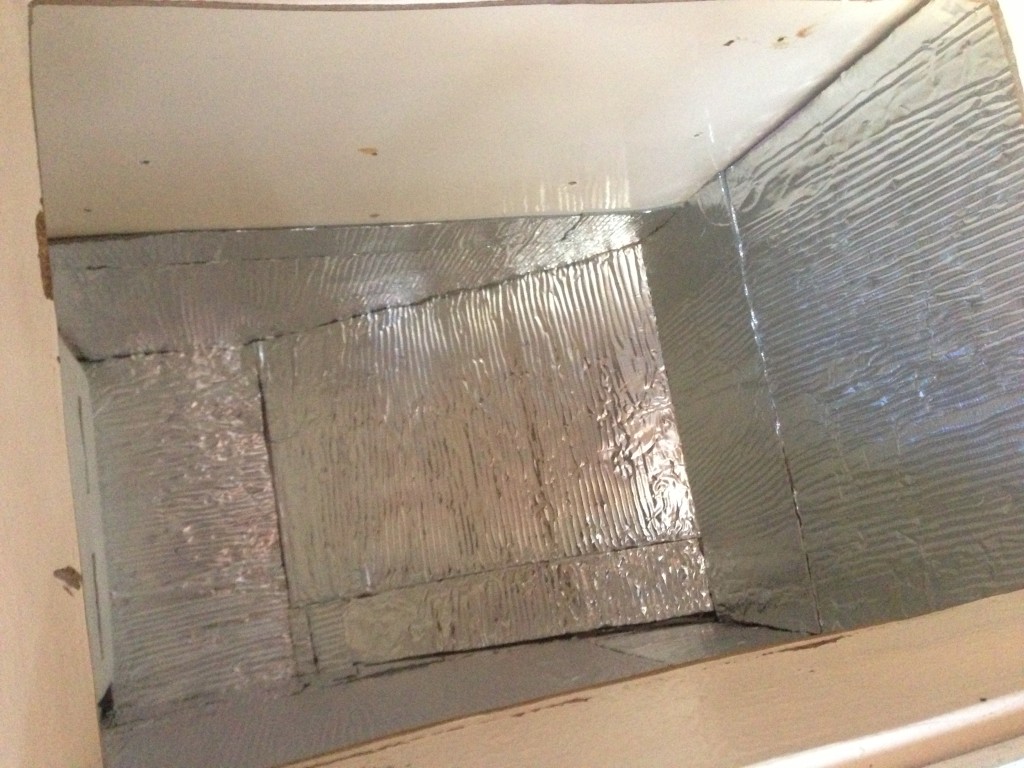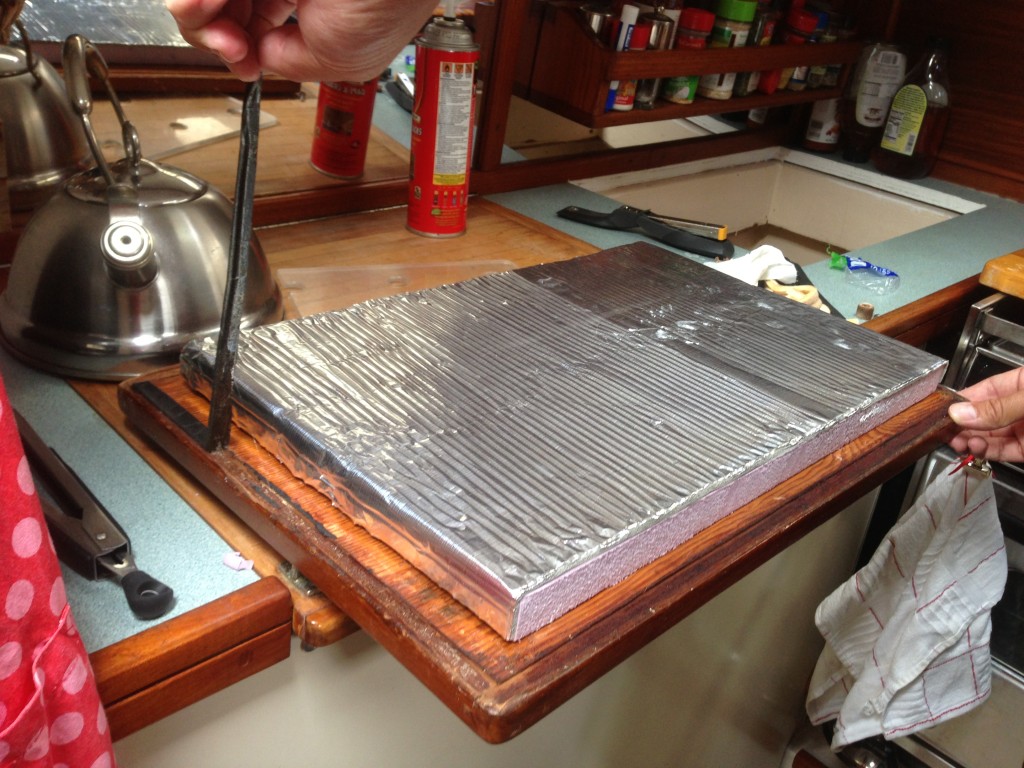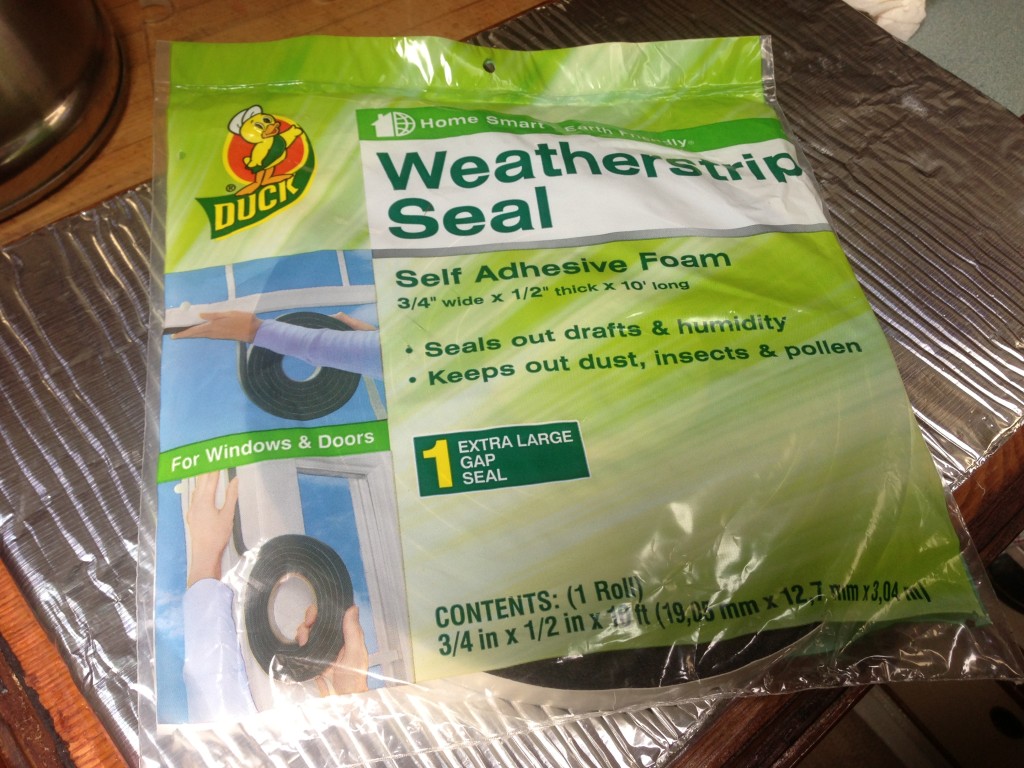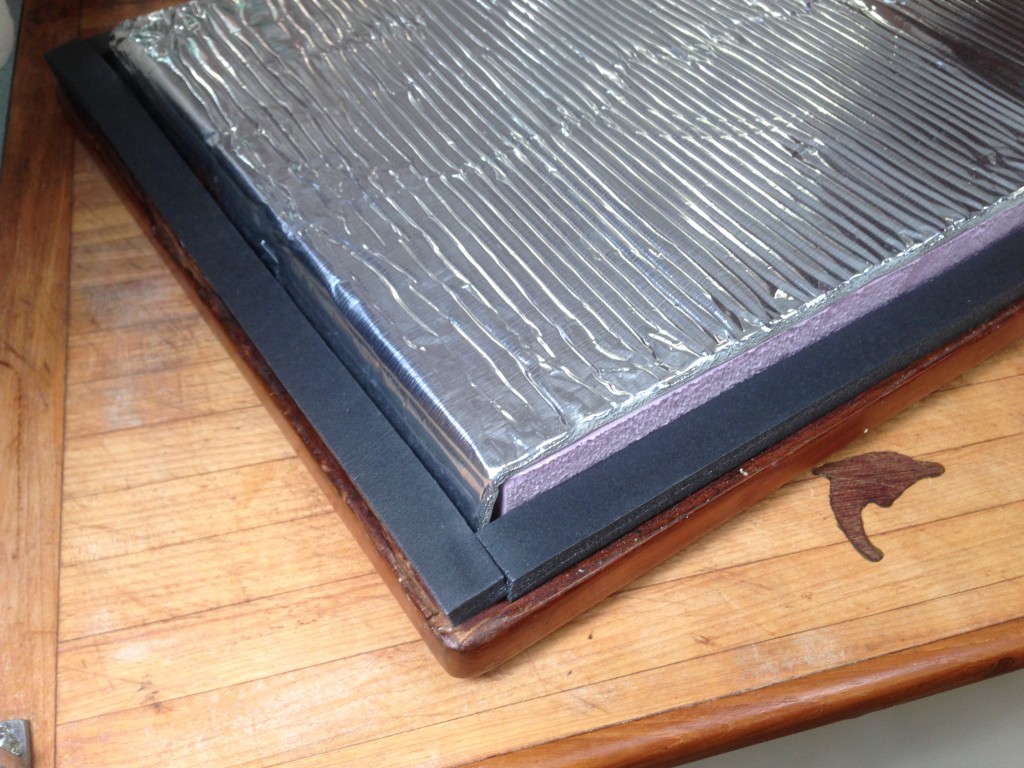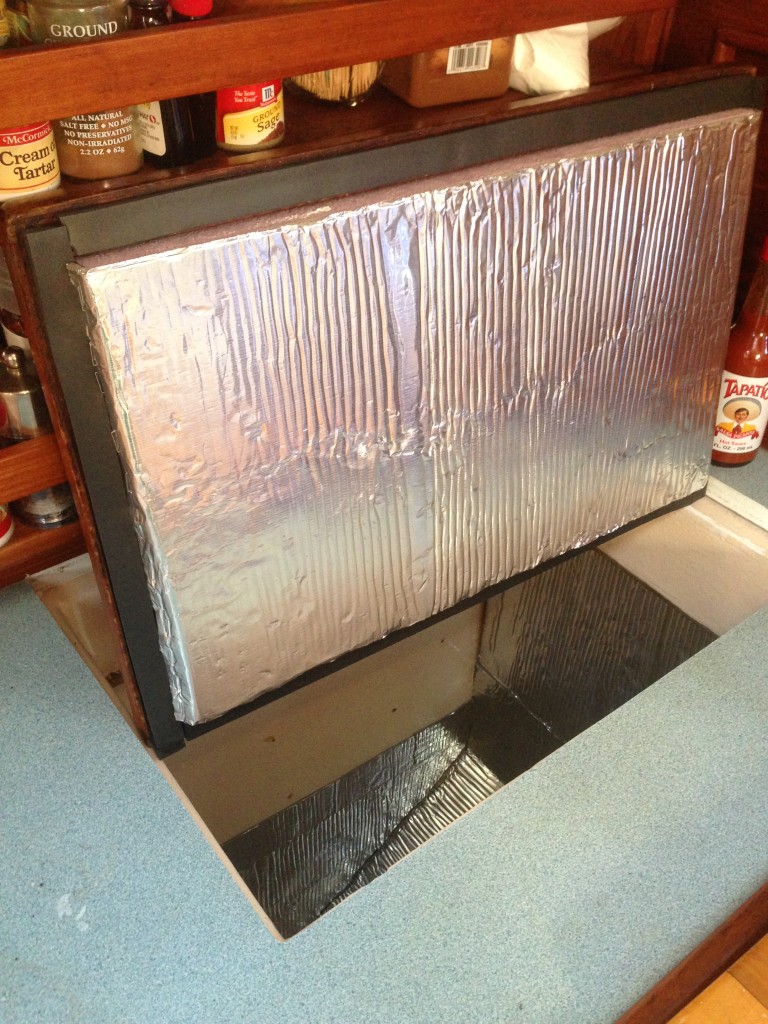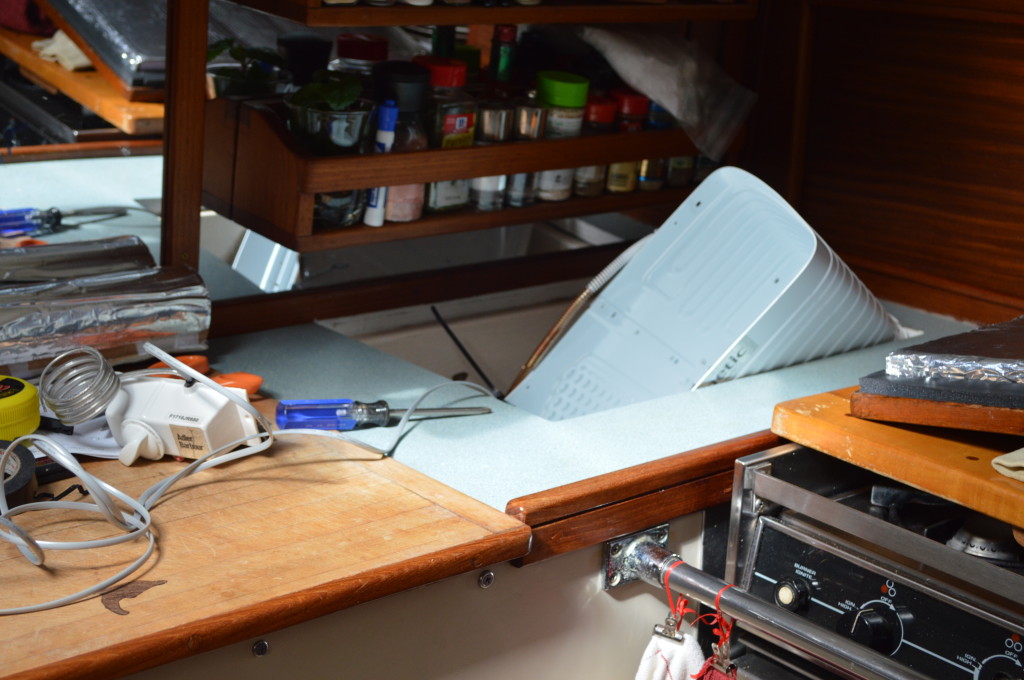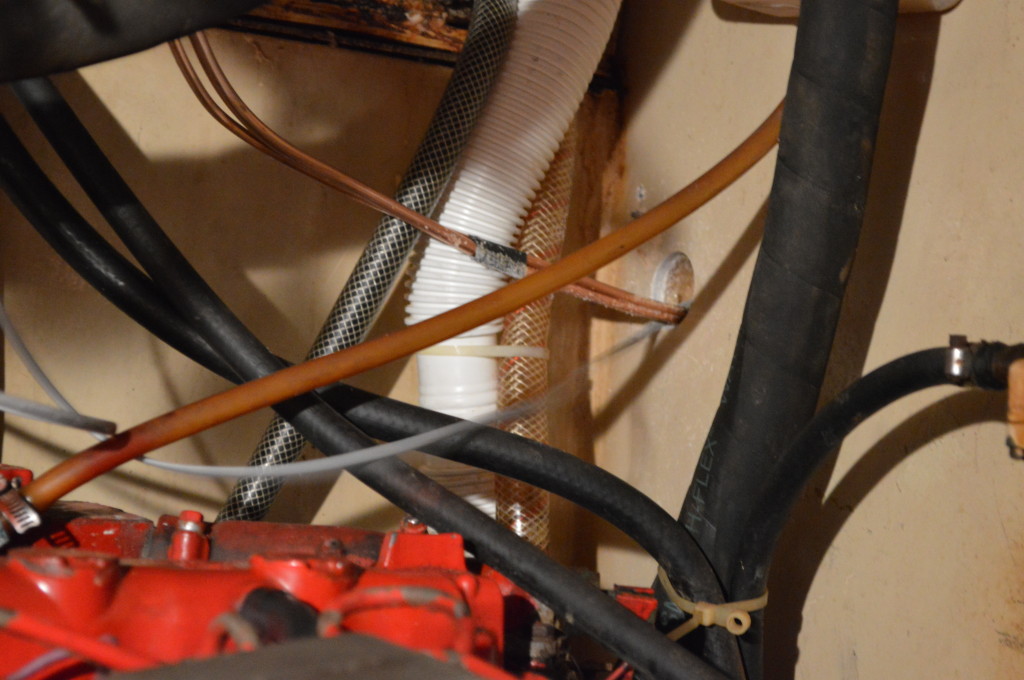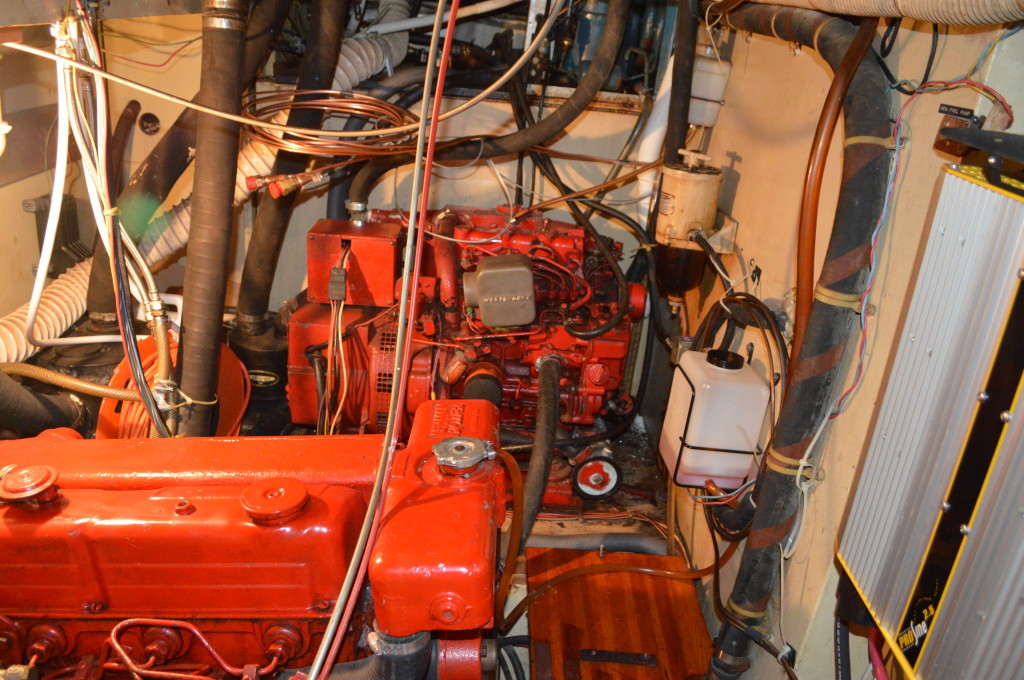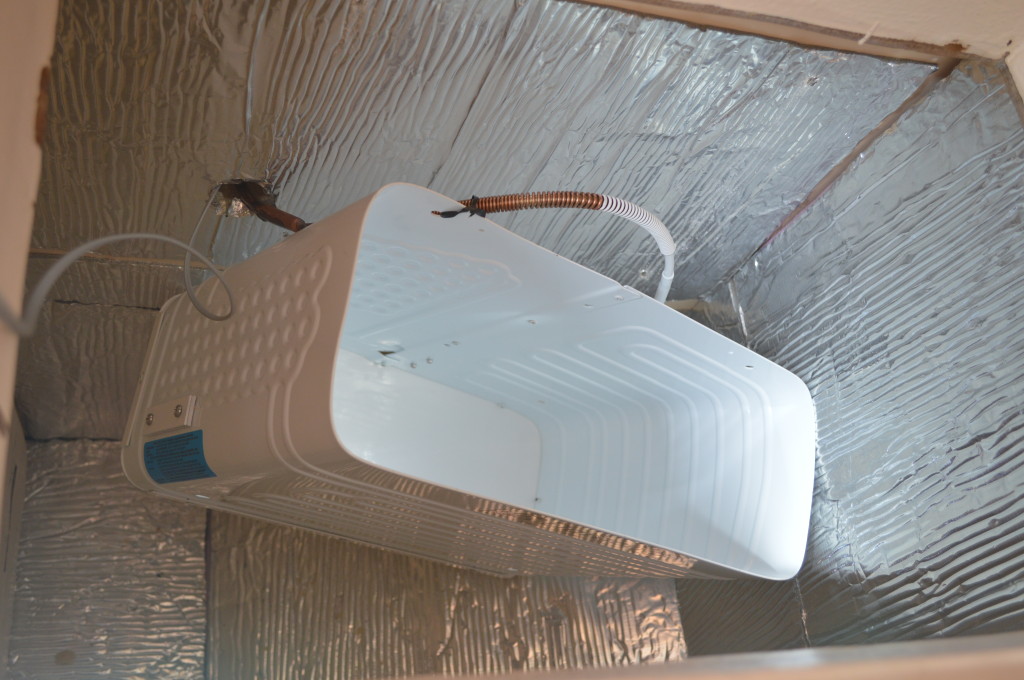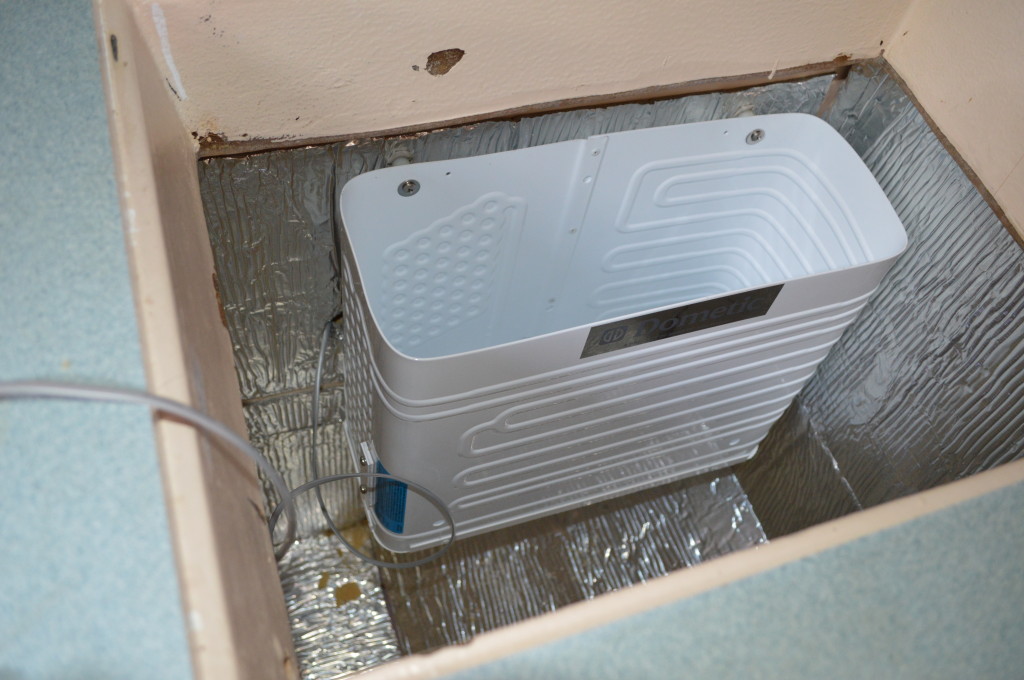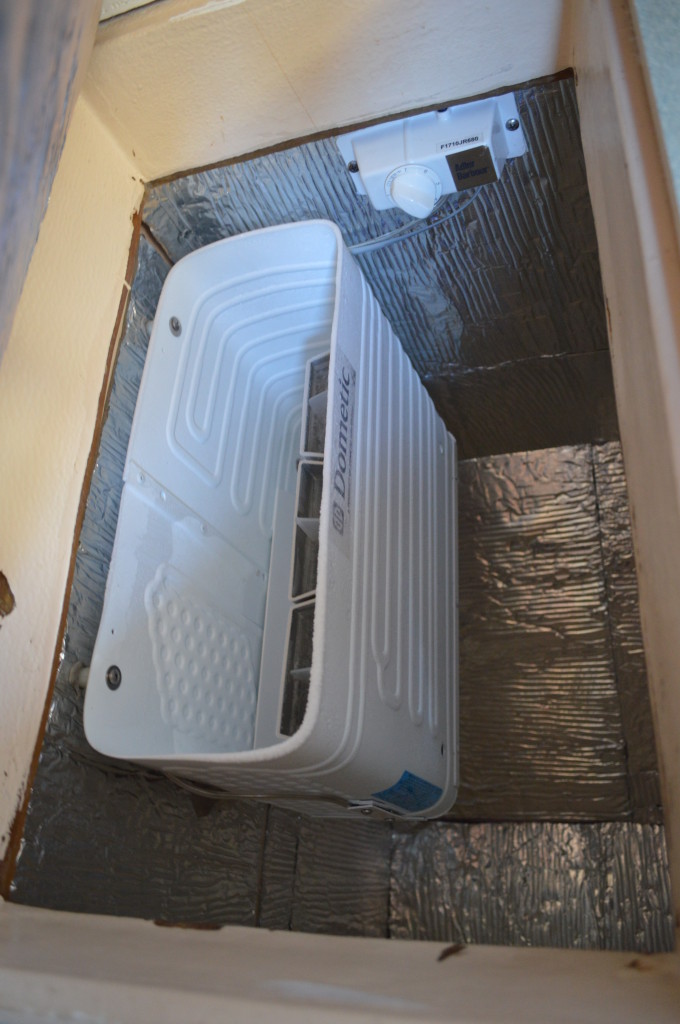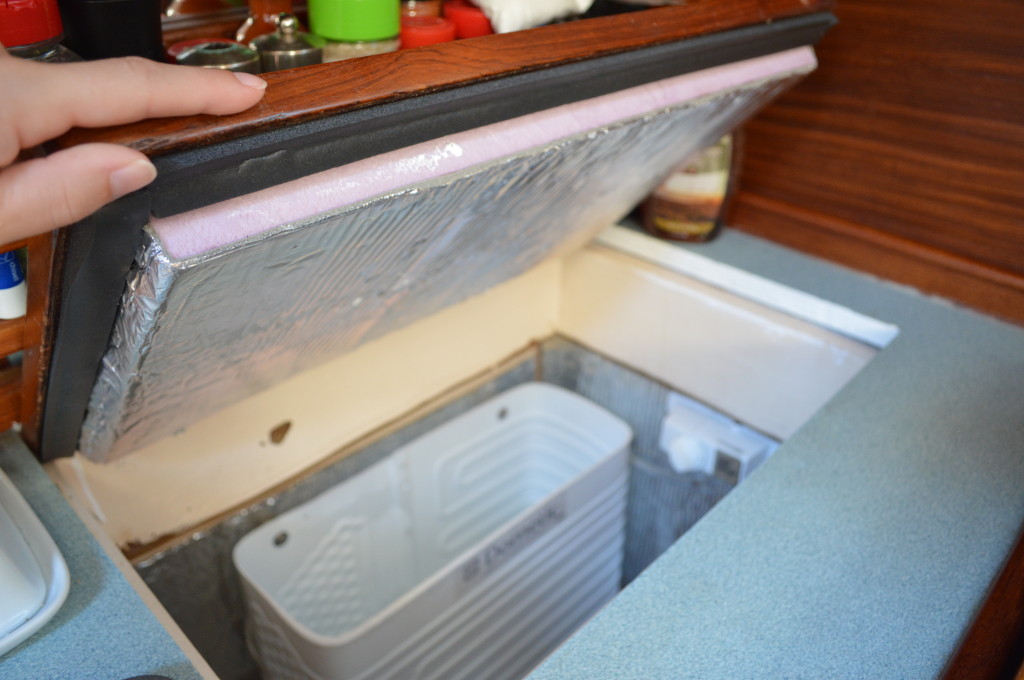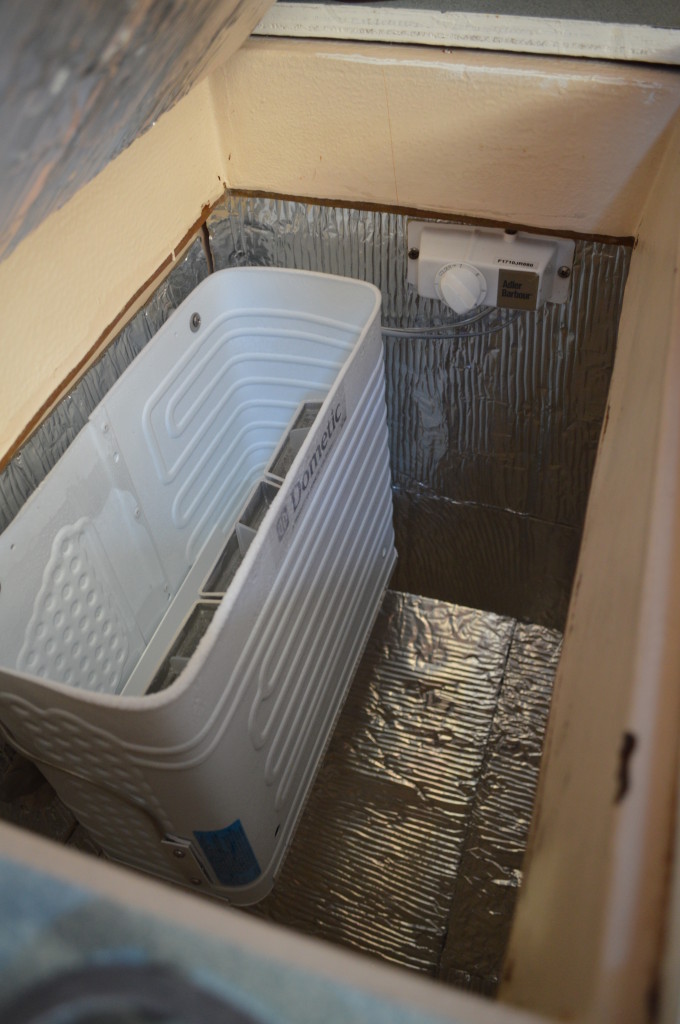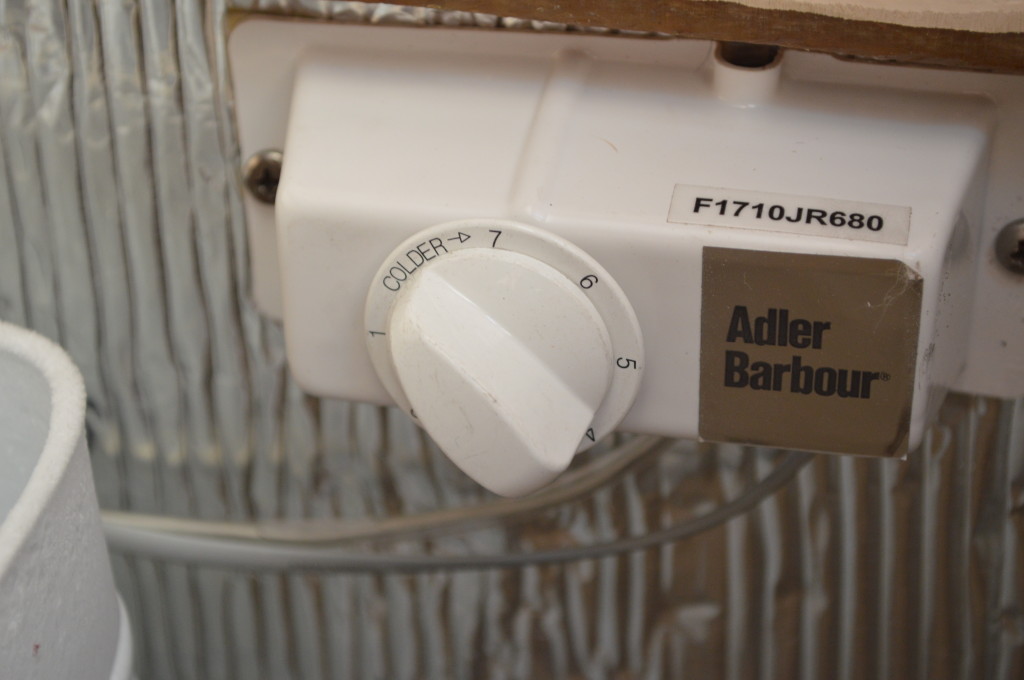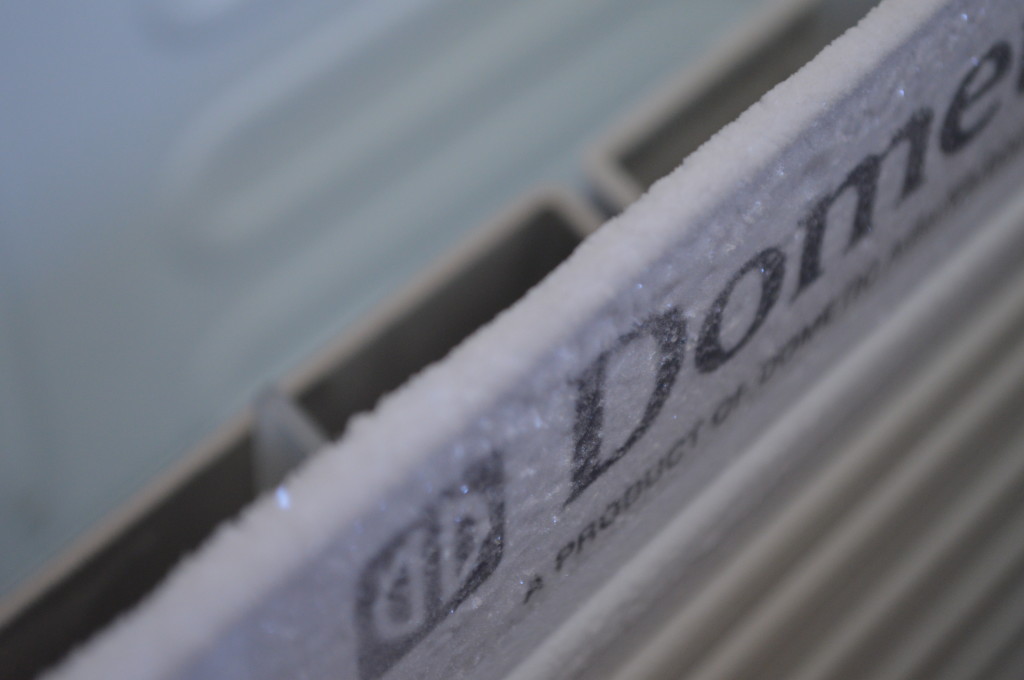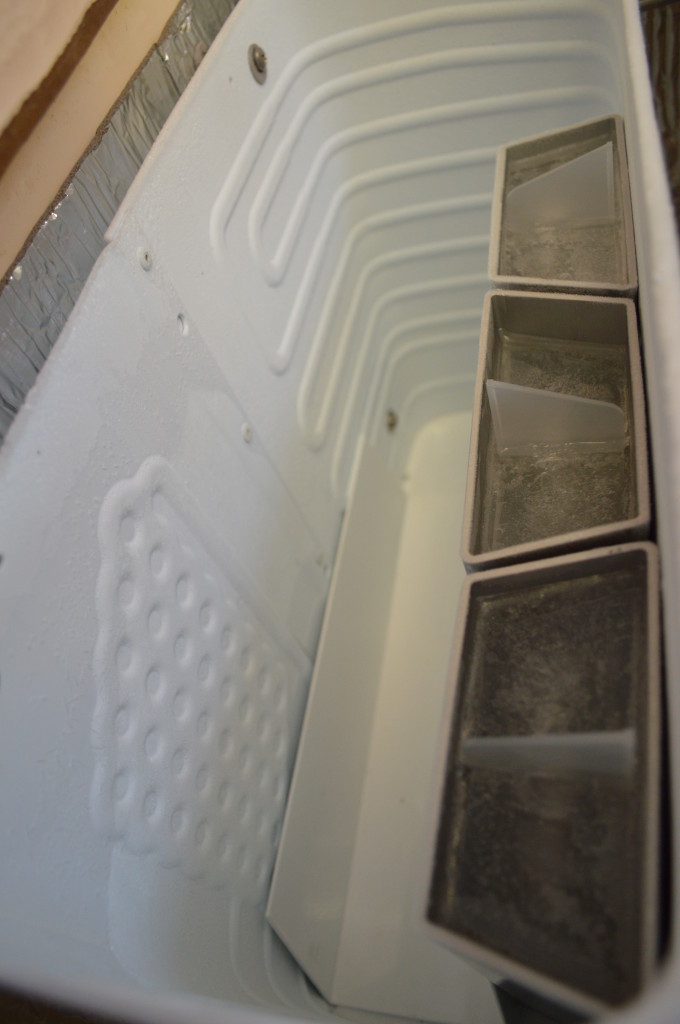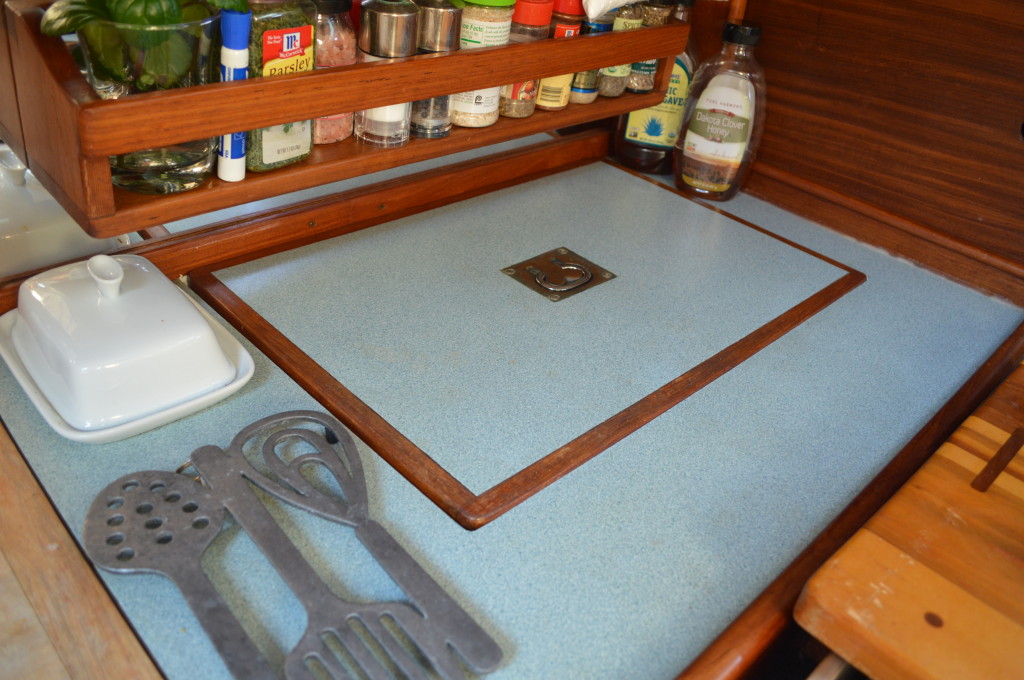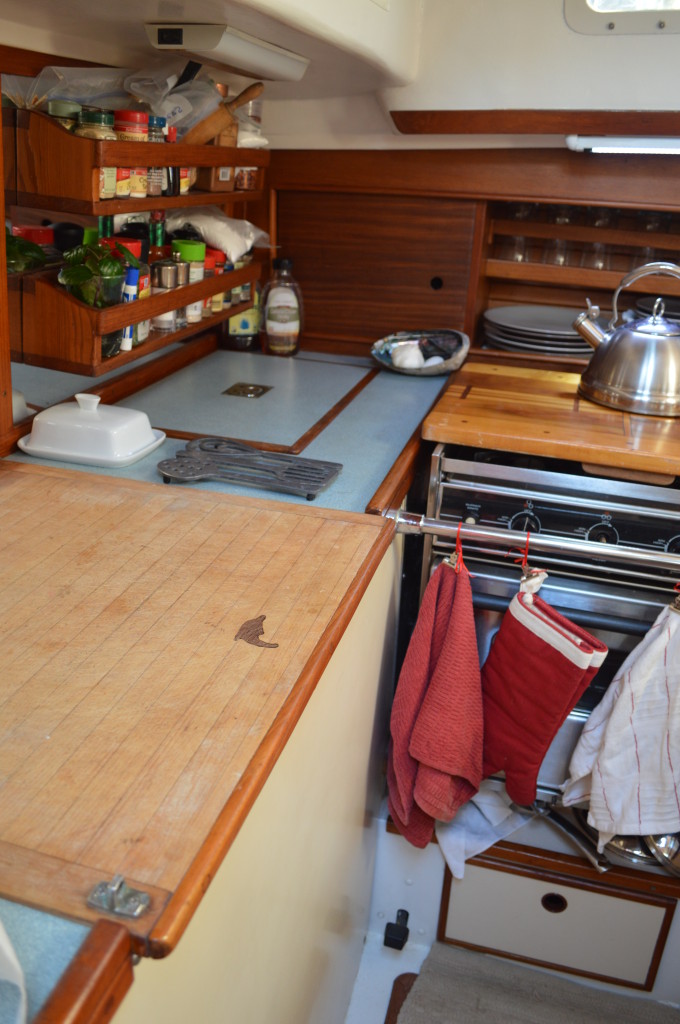Outfitting the boat with safety equipment was at the top of our priority list before sailing away from the marina last fall. Preparing for the safety of our dogs, Betsy and Gunner, was just as important as our own safety. Peter and I spent a good amount of time researching the best kind of dog life jackets to have for the kind of conditions we would be traveling in and soon found there were many factors to consider.
Visibility:
As with our own life jackets, bright colors and reflective material can greatly increase the visibility of our pups if they were to fall overboard. It’s much easier to spot colors like yellow, orange and pink than it is blue or black or green when floating at the water’s surface. Out at sea in the deep dark-colored water is where we are most concerned with having life jackets on. Every bit of visual aide can increase our chances of recovering a lost pup when all odds are against us.
Breathability:
Our voyage began in the hot Florida sun with relentless rays that bake everything in sight. Traveling where the coconuts grow will only lead us into hotter tropical climates from here on out where Peter and I will be wearing next-to-nothing with a little bit of swim suit and board short material to cover up. In the event that Betsy and Gunner would need to wear a life jacket, we needed to consider how breathable their life jackets would be to keep them comfortable.
I remember wearing a Scooby Doo zip-up life jacket on the docks in the San Juan Islands every weekend when I was a kid. The thick and bulky material gave me some extra padding as I would hang my head over the side of the dock to poke at sea anemones and scoop up little jelly fish, crabs and other sea critters with my net. It was the most uncomfortable and awkward piece of equipment but wearing it was non-negotiable and it kept me safe as I played near the icy water. On a cloudy day the life vest kept me warm and acted as a second winter jacket. When the sun came out that life jacket insulated my little body so well I was practically sweating.
Our sweet puppies can’t tell us when they are uncomfortable or too hot. Its our responsibility to make sure we select a life jacket that is best suited for hotter climates but that will still keep them safe. Many of the canine life jackets we found were all slightly different in regards to fabric selection and there were trade offs to consider as well. While the most breathable life jackets were appealing, they lacked in buoyancy and functionality.
Range of Motion:
Everyone knows Betsy Jo is an active dog. She bounces all around the boat and has free-reign pretty much anywhere she wants to go. When we are tied up to a dock she helps herself on and off the boat. When she is on deck, she patrols from bow to stern climbing over any obstacles in her way. On night passages or major crossings she curls up in a ball in the cockpit making herself comfortable while trying to not get seasick.
We wanted a life jacket that would allow the dogs to move around just as they normally do without any loss in range of motion. Harnesses can be tricky due to the placement of the straps that hold them on. If there isn’t sufficient chafe protection, straps can cut into their skin and create raw sore spots in the blink of an eye. We wanted neoprene to be the primary fabric supporting their weight for comfort but also for durability in the harsh conditions of the salt water and tropical rays of the sun.
In order to keep the life jacket properly in place, it is important to follow the recommended sizing charts for each brand of life jacket. Where Gunner might need a size Large for one brand, he is an Extra Large in others. Adjustable straps will help make the best fit, but the overall proportion of the life jacket is just as important.
Buoyancy:
Without getting too technical, there is a difference in the level of buoyancy each brand of life jacket has. Most are made for typical day usage in lakes or coastal areas. Unlike PFDs (personal flotation devices) available for people , there aren’t many dog life jackets that are suitable for off-shore emergency use.
We make it a rule to put life jackets on Betsy and Gunner while under way for any open-ocean sailing or during night passages. They always travel with us in the cockpit instead of staying down below to reduce the chances of seasickness. We don’t let them out of the cockpit while under way unless we are on a long passage, in which case we put our own inflatable PFDs on with tethers attached and escort the dogs to the aft deck to do their business. Rolly seas can be dangerous if we or the dogs were to lose our balance and go overboard, especially in the dark.
We’ll leave it up to the scientists to calculate just how much flotation a life jacket can provide. Ruff Wear has a great post about how much buoyancy is recommended for dog life jackets. For us, it comes down to having as much buoyancy as possible so that if one of our dogs were to go overboard while under way, they would be able to float comfortably if/when they got too tired of doggy paddling, even in stormy conditions. We pray it will never happen in an emergency situation out at sea, but safety precautions like these help keep our furry children safe.
Another feature we liked was the front float for keeping their heads above water if swimming for long periods of time. Betsy is a practically a fish and is an excellent swimmer but if she were ever floating out at sea in need of rescue, keeping her head above water is critical when exhaustion and dehydration might set in. Gunner’s older joints and muscles aren’t as strong as Betsy so he needs as many safety features as possible.
Handles and Straps:
Both of our dogs wear a special hip-lift harness on daily basis while under way for added safety even on the calmest of days or shortest of trips. They have two handles each for easy lifting if they were to fall off of a dock or for lifting them into and out of the dinghy. We leave the harnesses on all day and remove them only when they are sleeping so it’s not uncommon for us to leave their regular harnesses on underneath the life jackets.
Just like with their regular harnesses, it was imperative that the life jackets have good placement of the lifting straps to provide proper support either by hand or by boat hook. I didn’t like the ones that had a strap going under their neck or the ones that wouldn’t evenly support their weight. Gunner is 75 lbs and Betsy weighs in at 50 lbs. Some people argue that by grabbing the rear handle it could force the dog’s head underwater so one handle between their shoulder blades is better. It would be easy to scoop up a smaller dog one-handed if they were to fall over board, but it’s not so easy with large dogs. It’s our personal preference that two handles is a must-have feature for us.
The first four months we lived on the boat was at a marina where the tide would fluctuate greatly. Sometimes the dogs had to jump up from the dock 3 feet or higher and sometimes it would be a jump down. Being able to hold on to them as they jumped onto the boat gave an incredible amount of piece of mind. It was also good practice for handling the dogs while out at sea when the boat is rolling all over the place.
Cost:
Dog life jackets can range from $20 to $100 depending on size and brand. When it comes to safety, $100 is a small price to pay for piece of mind. Of course we would prefer to go with the most economical choice, but this is the least important criteria to us. It pays to shop around and do the homework to know if a certain product is a rip-off, but for the different products we found available, the prices all seemed relative. Finding the best option for offshore application was our top priority.
Reviews:
There are several reviews and brand comparisons floating around on the web naming some of the major brands. Here are a few of our own opinions of what’s on the market today:
- Pros: Durable, adjustable, XXS through XL sizing, excellent buoyancy
- Cons: Poor breathability, bulky, only one handle, expensive $80, doesn’t completely wrap under the belly
Kyjen Outward Hound Life Jacket
- Pros: Durable, excellent visibility, sufficient buoyancy, excellent handle and strap placement, affordable $20-42, excellent range of motion, front float, XXS through XL sizing
- Cons: Not the most breathable but any more ventilation would only reduce the buoyancy
- Pros: Affordable $18-35, reflective trim, two straps, comfortable, XXS through XL sizing
- Cons: One handle, thick, poor breathability
- Pros: Durable, reflective trim, XS through XL sizing, removable floatation liner, extra insert for warmth available, two handles
- Cons: Too hot for the tropics, expensive $57, doesn’t completely wrap under the belly where the second handle is, doesn’t stay in place, average buoyancy
MTI Adventurewear UnderDog Canine Life Jacket
- Pros: Excellent breathability, medium pricing $40, available at West Marine, excellent range of motion, front float
- Cons: Limited buoyancy, poor topside visibility for open ocean use, poor durability (many had stitching coming apart brand new on the shelf in the store (some debate that having floatation on the under side of a dog is better for keeping them afloat but we were concerned with tipping easier in cases of exhaustion floating at sea. Excellent lightweight and breathable design for coastal or lake use, but not ideal for offshore application.
- Pros: XXXS (under 15lbs) through XL sizing, excellent visibility, adjustable neoprene straps, durable
- Cons: Expensive $40-62, lacking full belly support, one handle
Critter’s Inflatable Pet Life Vest
- Pros: Suburb breathability, buoyancy and range of motion, automatic CO2 inflation when submerged in water, front float for head support, adjustable size S, M and L (from 6-200lbs)
- Cons: Expensive $70, Automatic inflation could accidentally be triggered in damp or flooded wet lockers, support straps have no chafe protection
As with any research, we could have spent days reading the pros and cons of all the different types of dog life jackets. Instead, we narrowed the list down to one or two that would actually provide the safety features we want in offshore tropical conditions.
Kyjen’s Outward Hound Life Jacket was our top pick based on all criteria. Back in November 2013, Kyjen Inc. generously sponsored our adventures by providing us with two of their Outward Hound life jackets to keep Betsy and Gunner safe. Kyjen is a top-of-the-line manufacturer of a wide range of products just for dogs. If you haven’t seen their brand before, be sure to check out all the fun and ingenious products they have available.
Before we left the dock for good back in February 2014, we made sure to fit the new life jackets for size and have the straps properly adjusted. Betsy and Gunner didn’t mind wearing them at all and seemed quite comfortable lounging around as usual. Our first overnight passage from Burnt Store Marina to Marathon was the first real piece of mind we had when the Outward Hound life jackets went on. We knew our dogs were safe. We were equally as relieved to put the life jackets on Betsy and Gunner while crossing the Gulf Stream from Florida to the Bahamas. Although the dogs haven’t gone overboard with the life jackets on yet, we are confident they would keep our pups safe in an emergency situation.
Stay tuned for more pictures when we test them out for an afternoon swim!!
**If you’re in the market for a life jacket for your furry friend, please consider using one of our Amazon Affiliate product links above. Just access Amazon by clicking through from our website first and any subsequent products you search for during that same internet session will help us out when you complete your purchase. It’s no additional cost to you and puts a small percentage in our cruising kitty to help us buy more dog food for our furry children.
IN CASE YOU WERE WONDERING… We are PROUD to share these awesome products and services with our readers. There are so many different solutions out there for everything we could possibly need, but these are the solutions that work for us.
This post may contain information about a product sponsorship. We gladly accept discounts or samples when a company feels generous enough to support our cause. In return we support the manufacturer or local service by sharing their links and writing about our experience with them. We only seek out sponsorship and affiliate programs from products and services we actually WANT to use and likewise only accept offers for products or services that we WILL use. We are not paid for any reviews we write or feedback we provide. We simply like to spread the word and share great experiences we have had that could also bring joy to others.
Thanks for following our adventures as we travel in search of surf, sun, sand and serenity WHERE THE COCONUTS GROW!!

